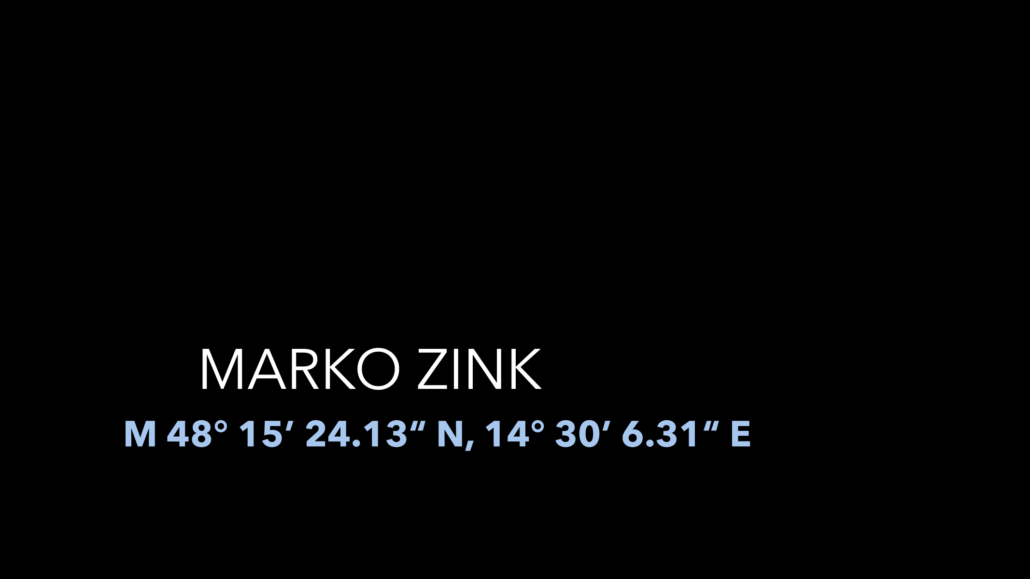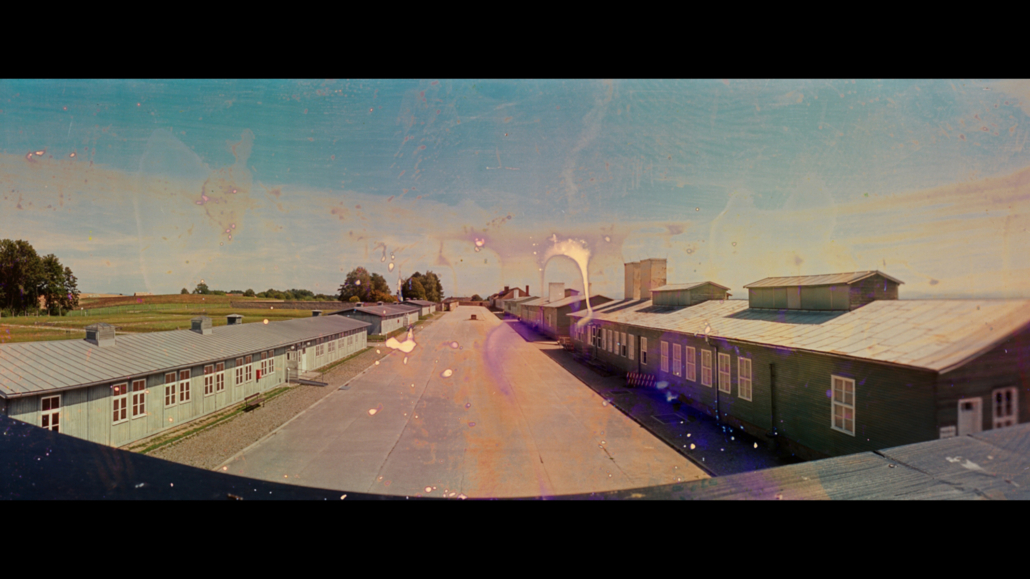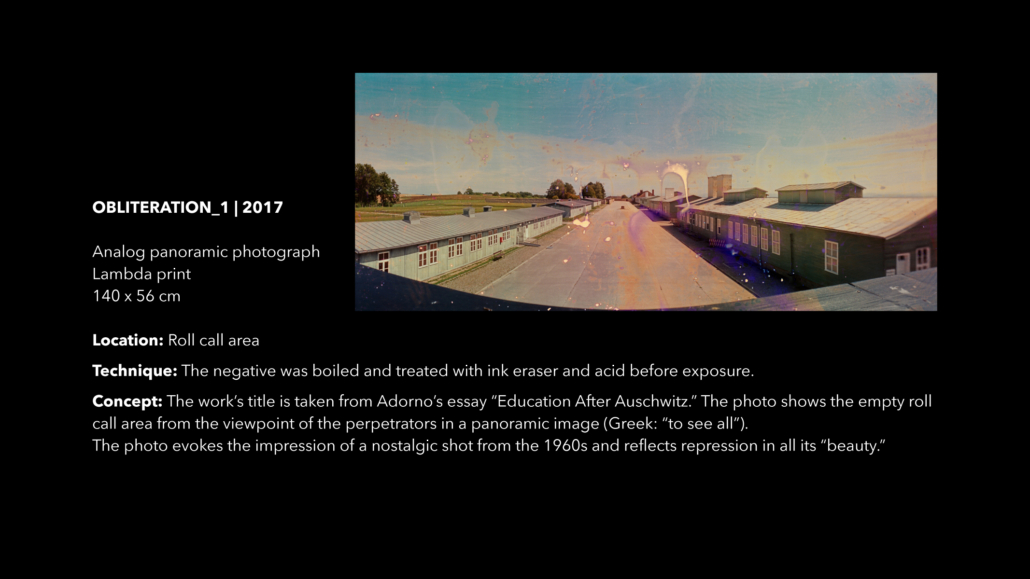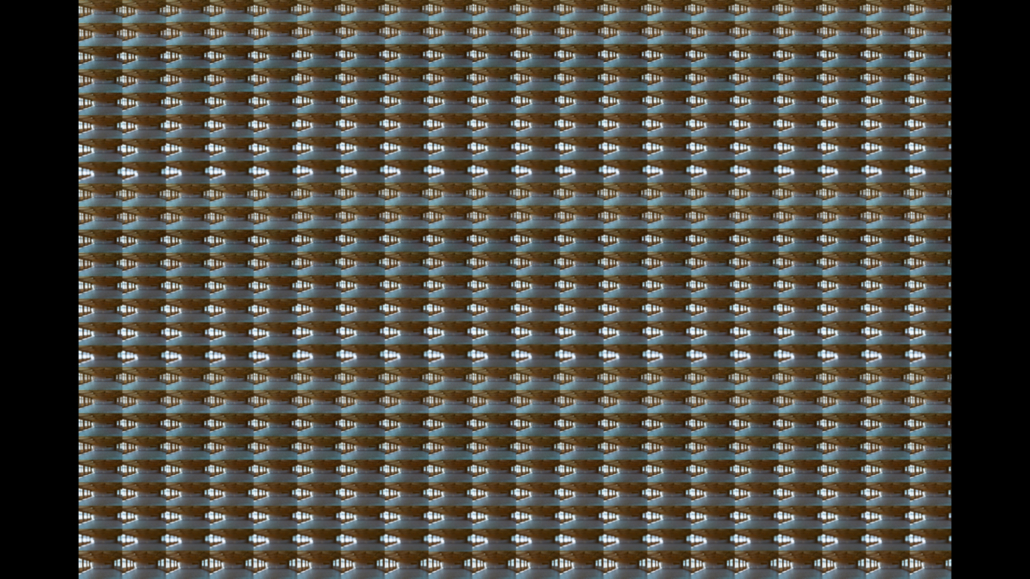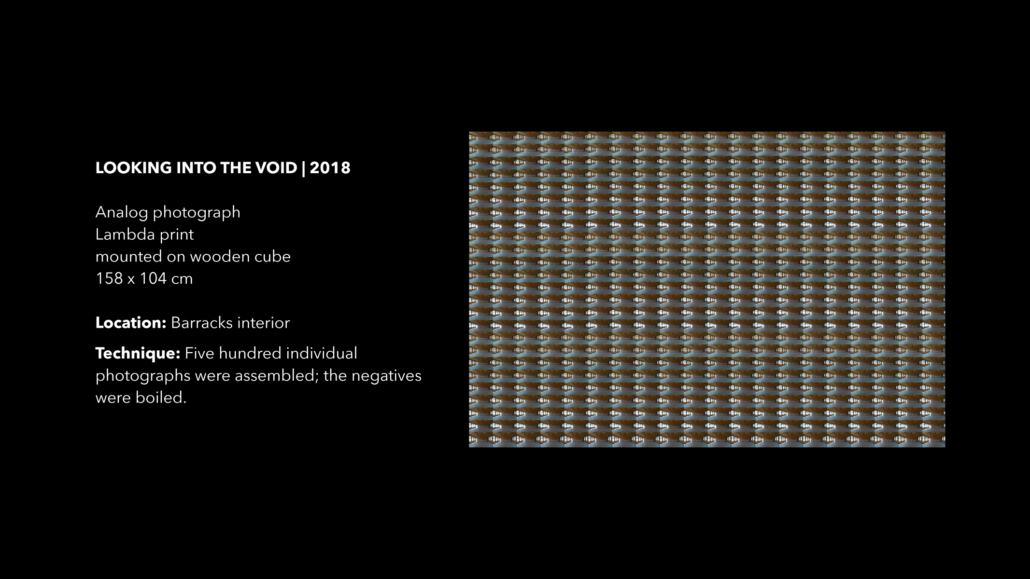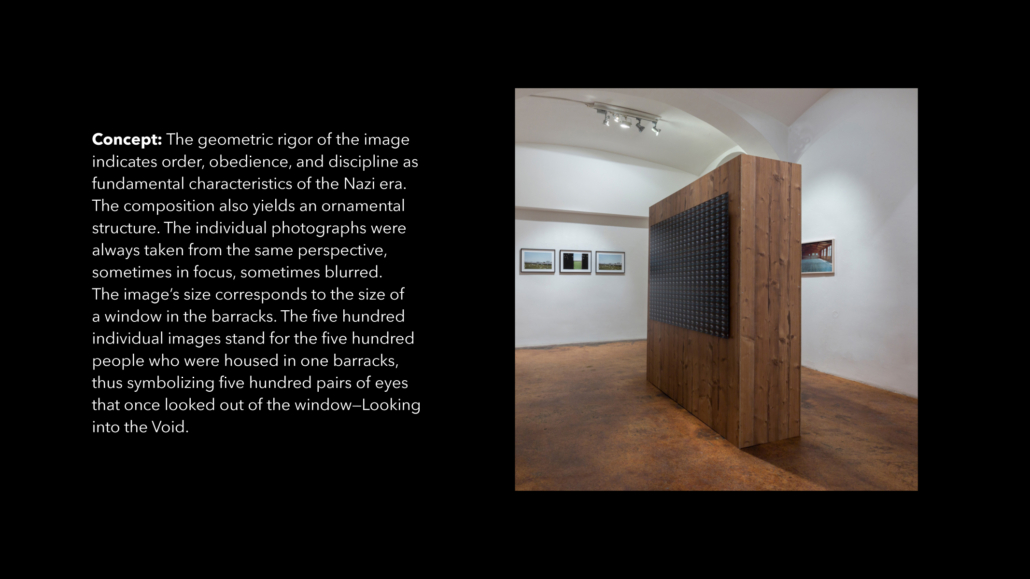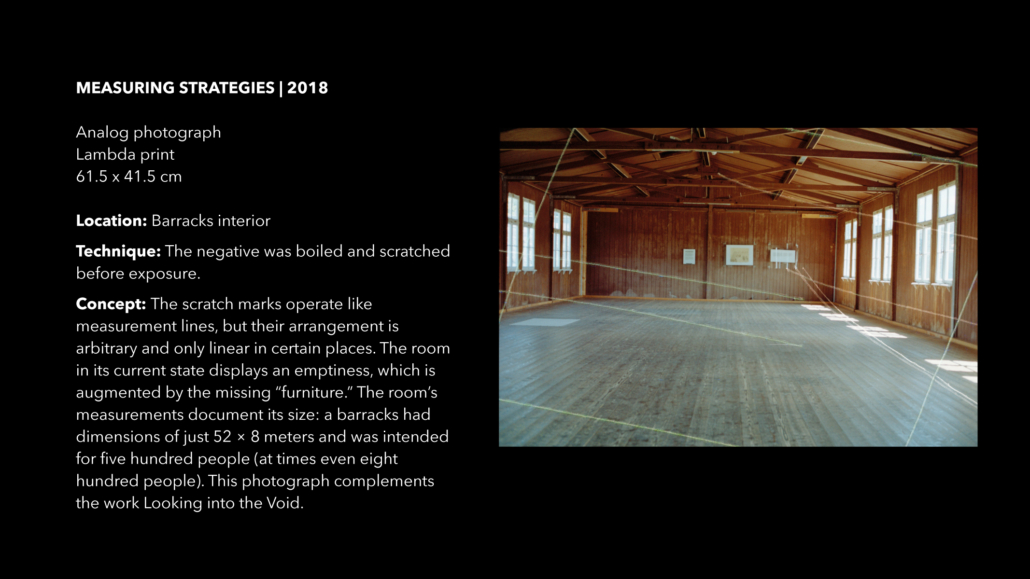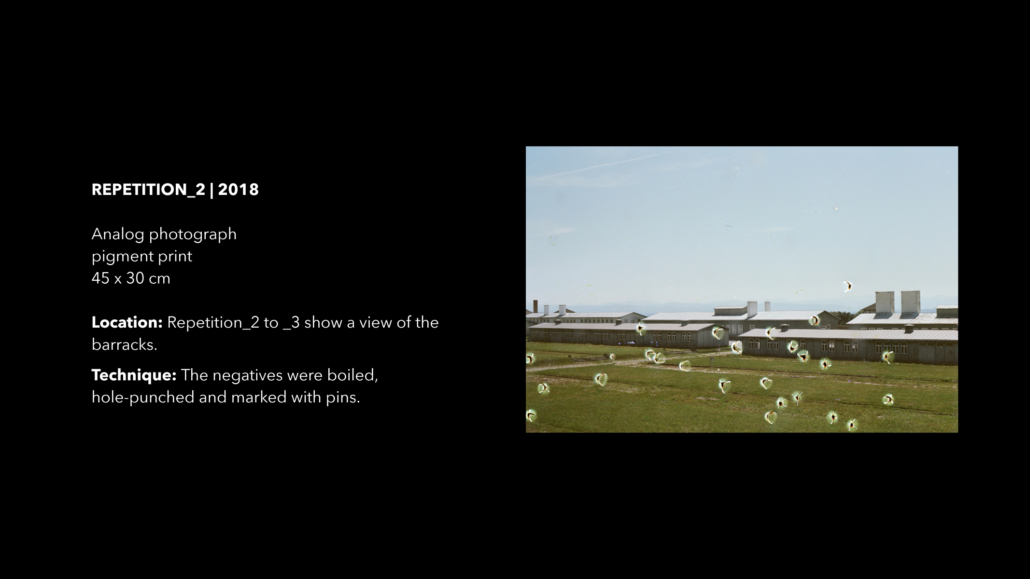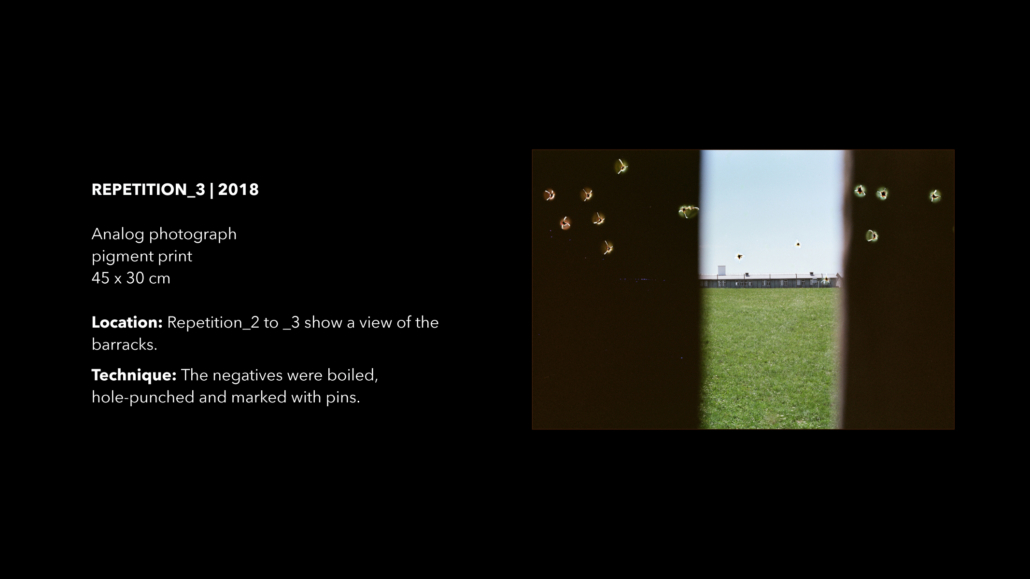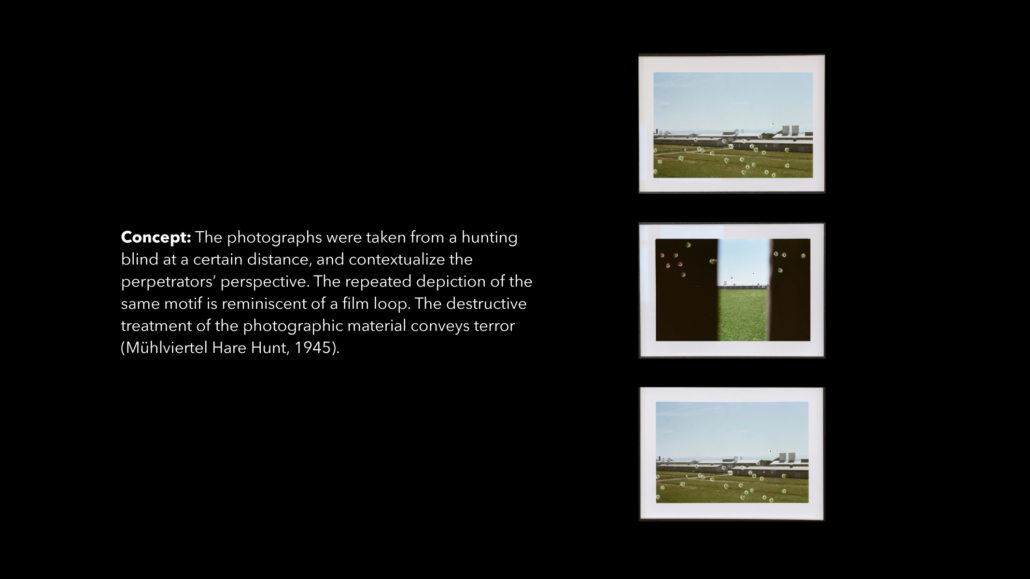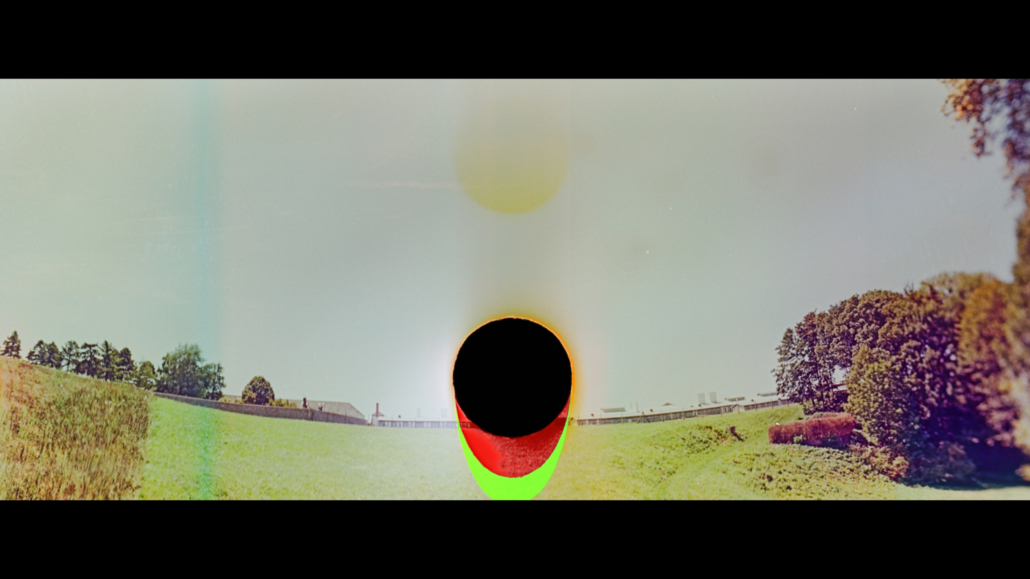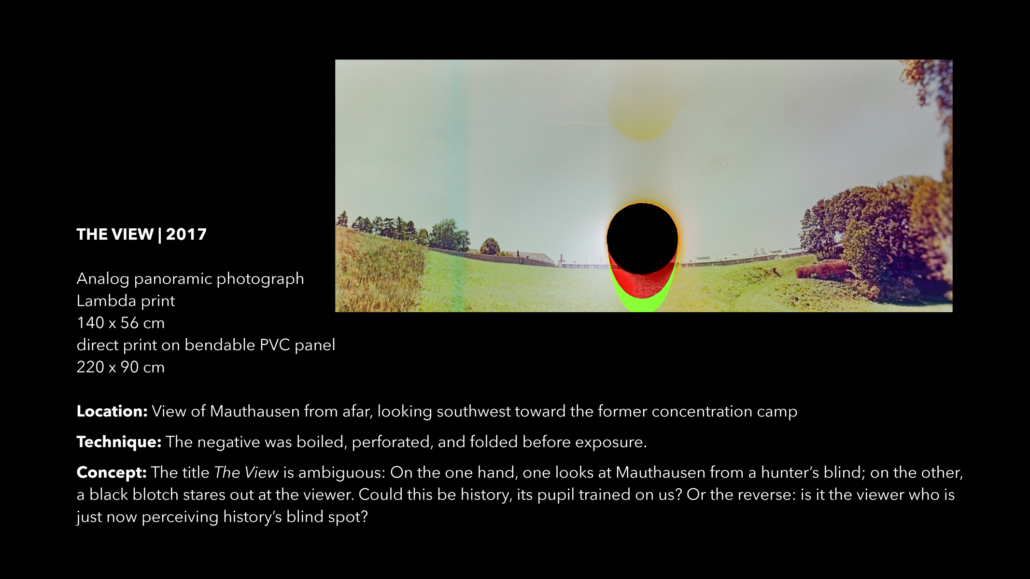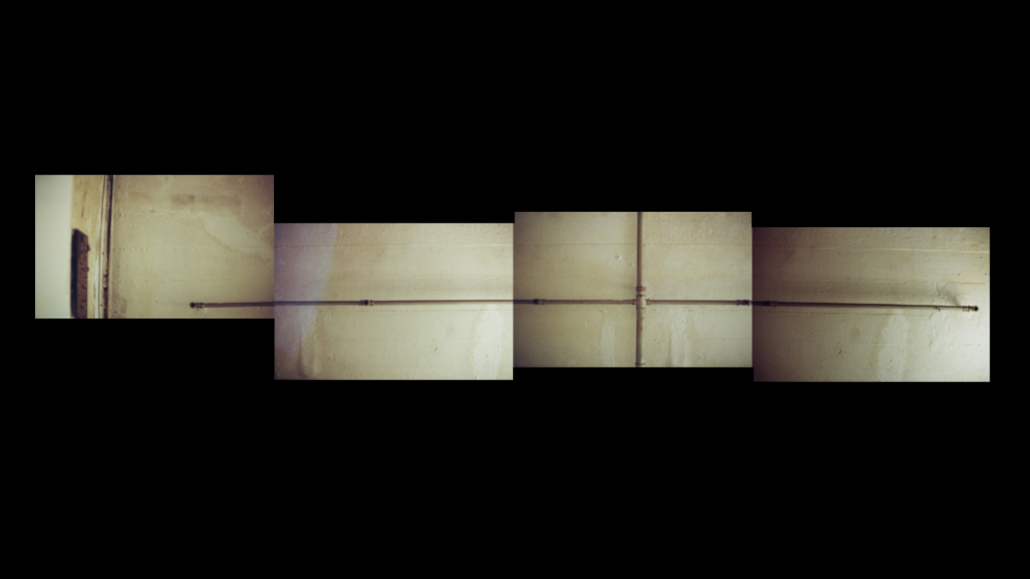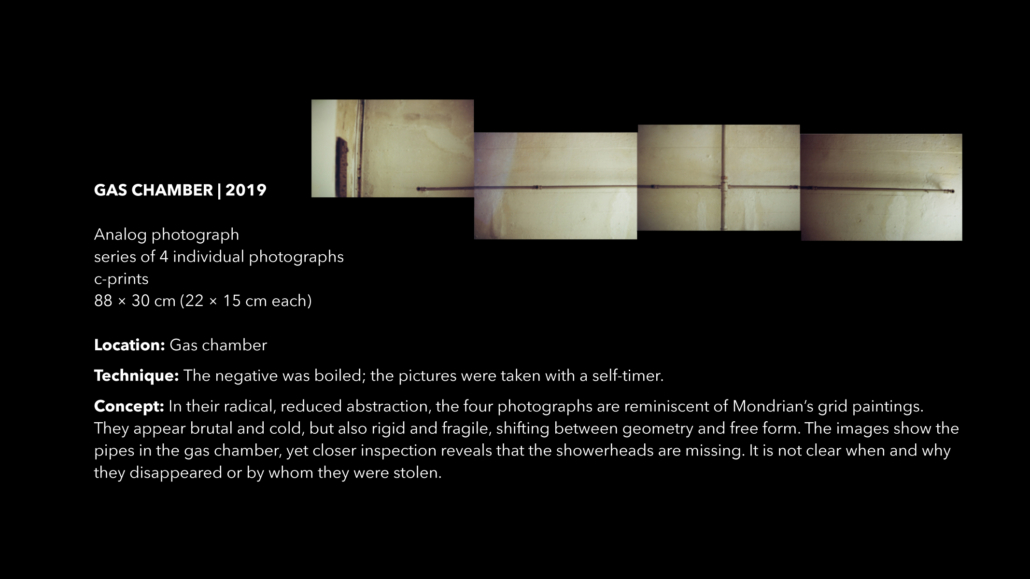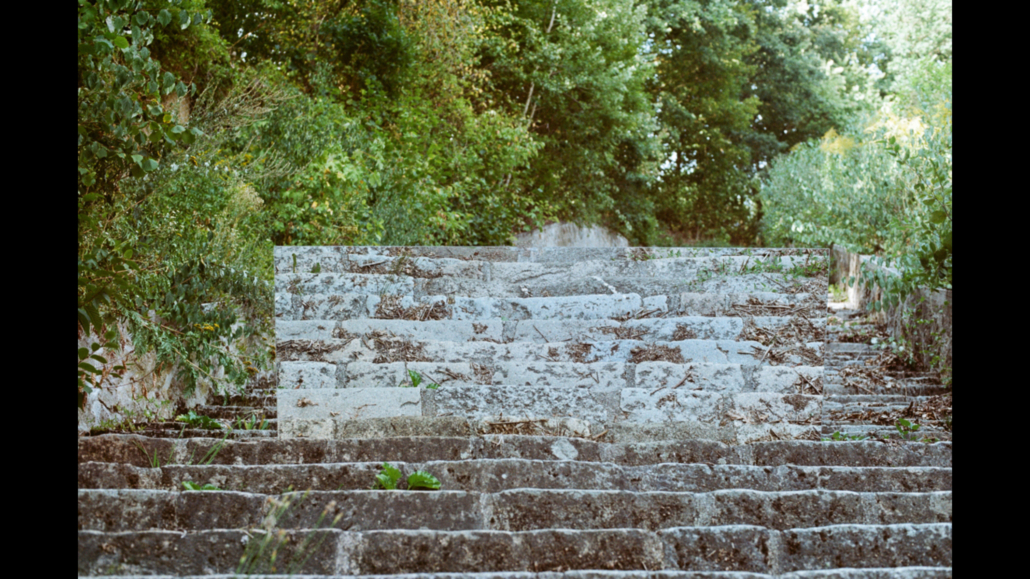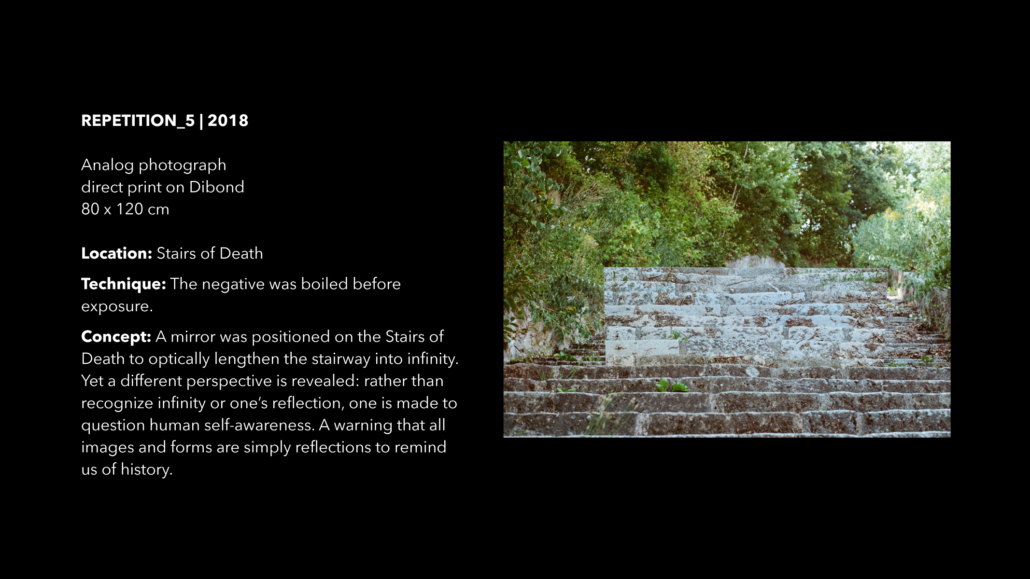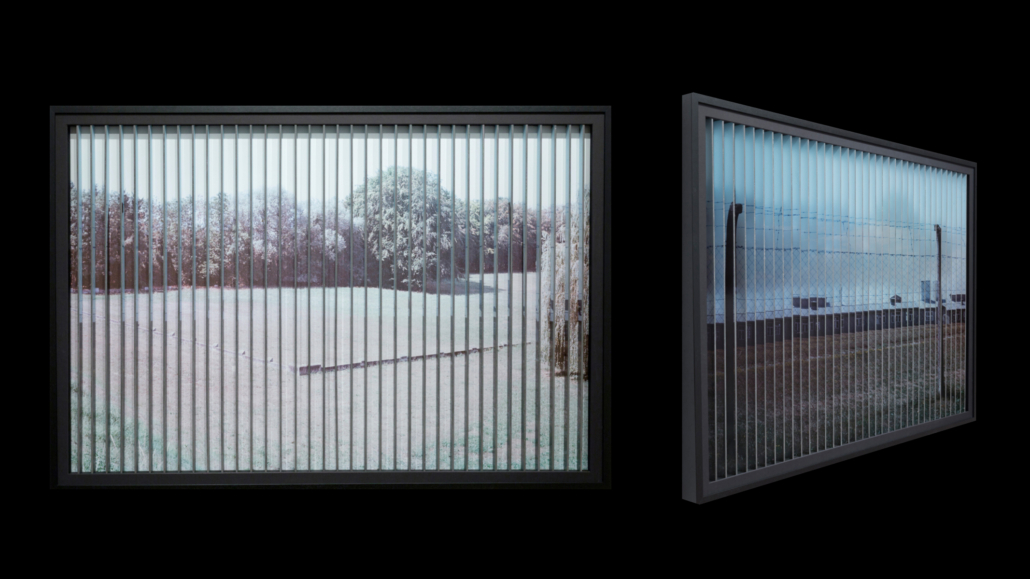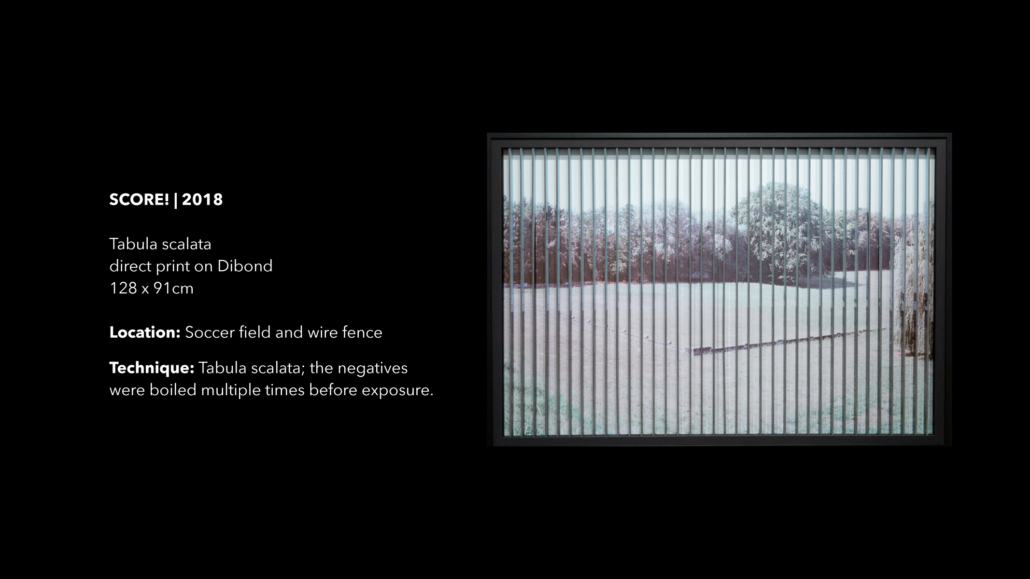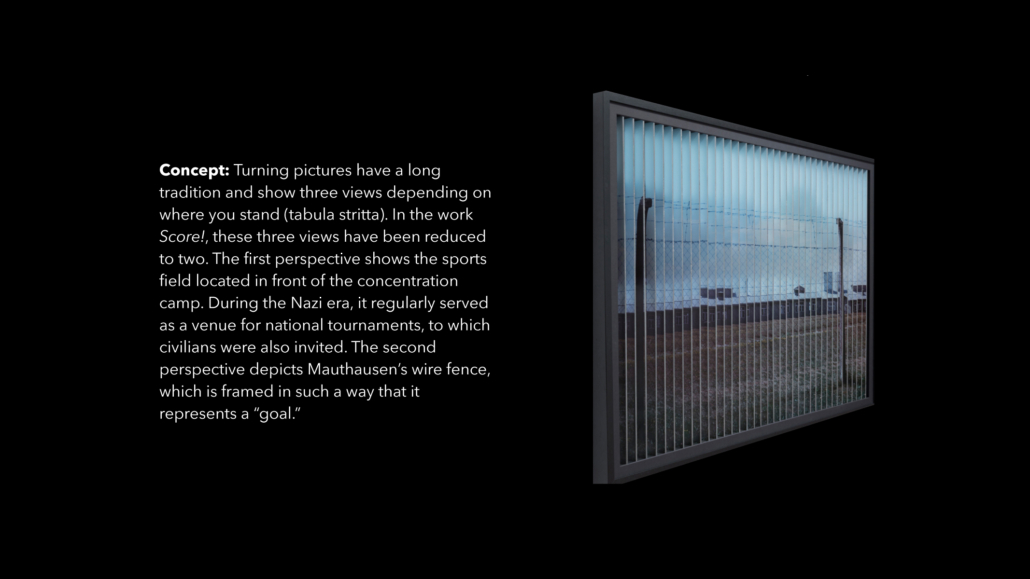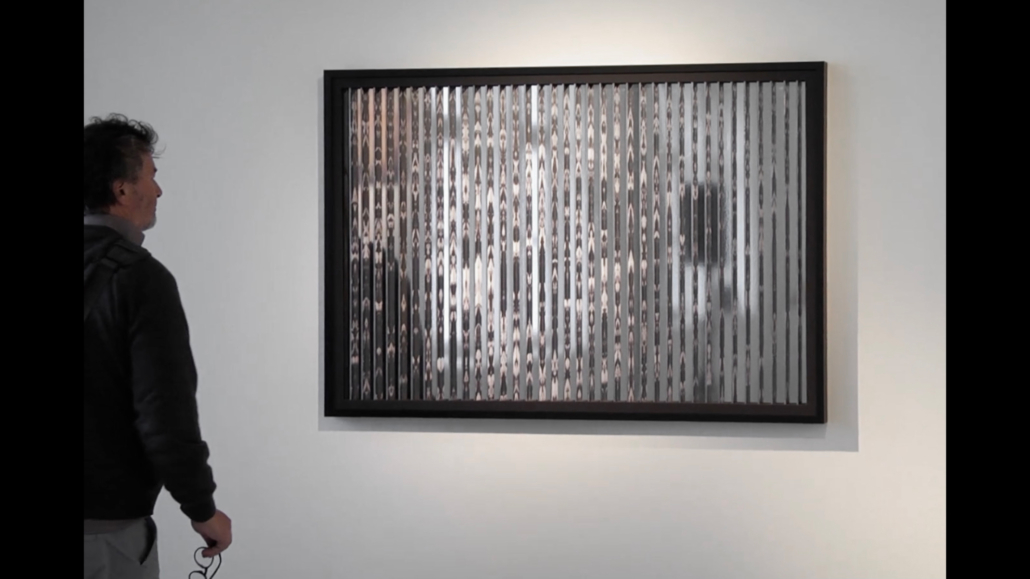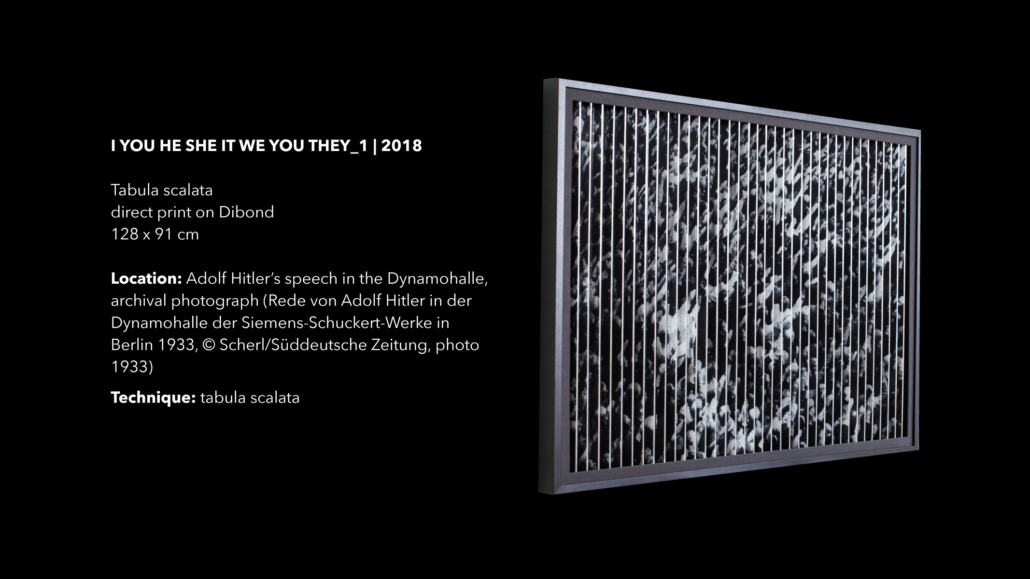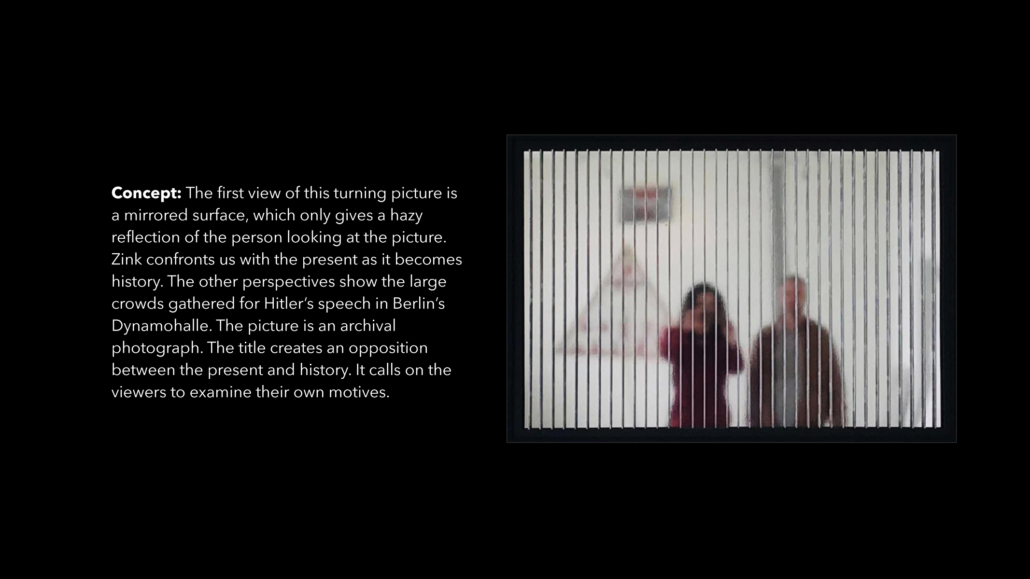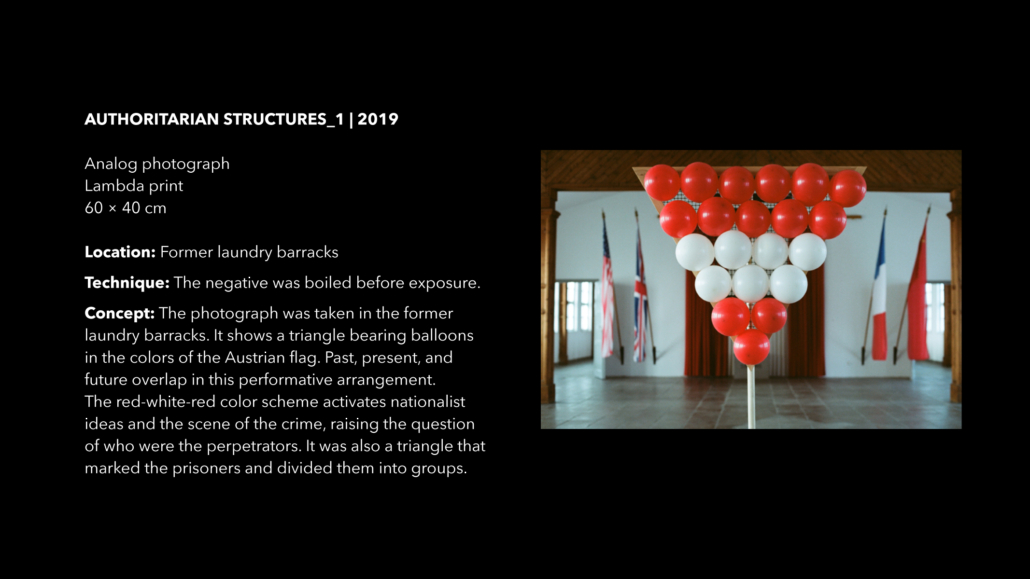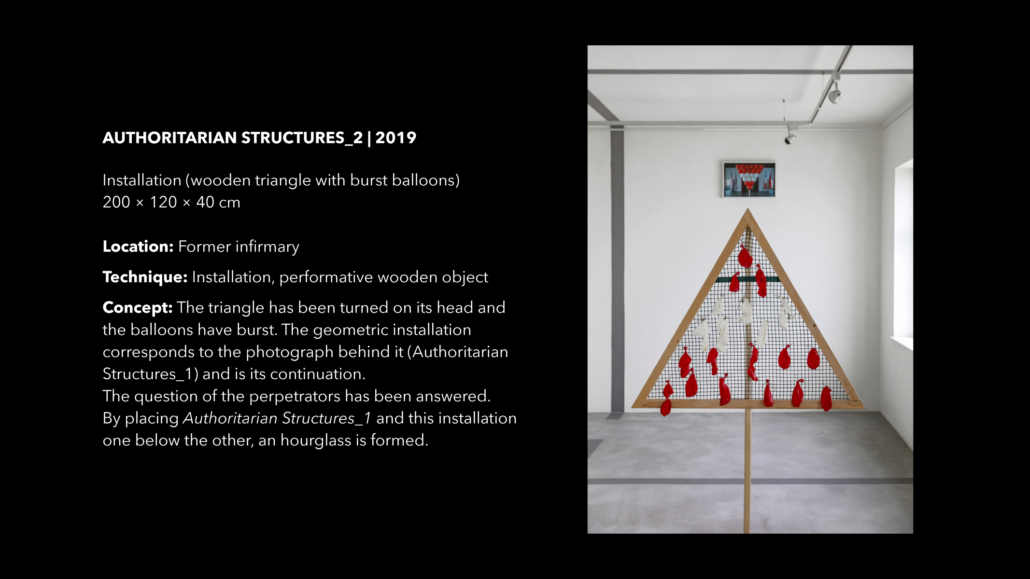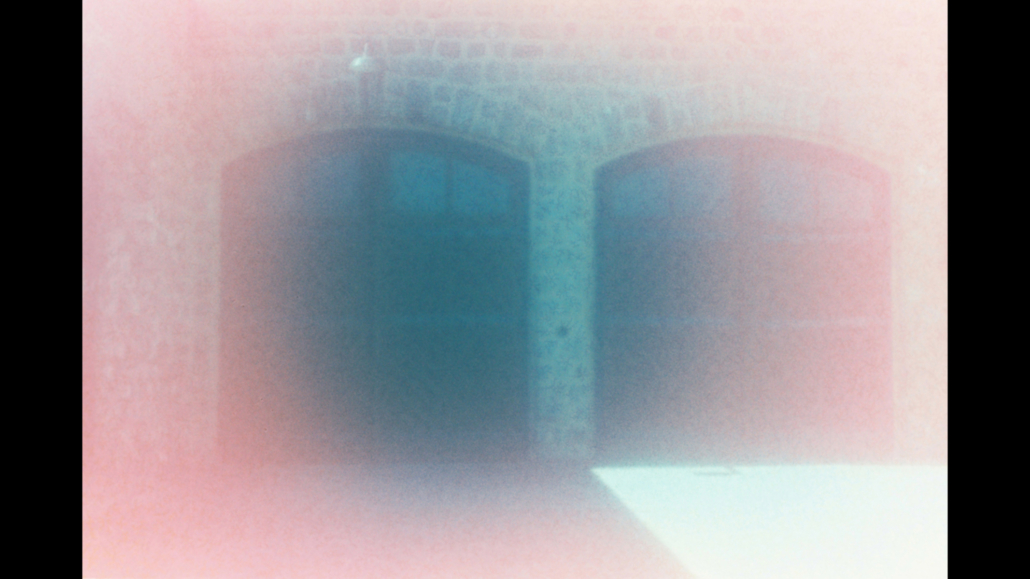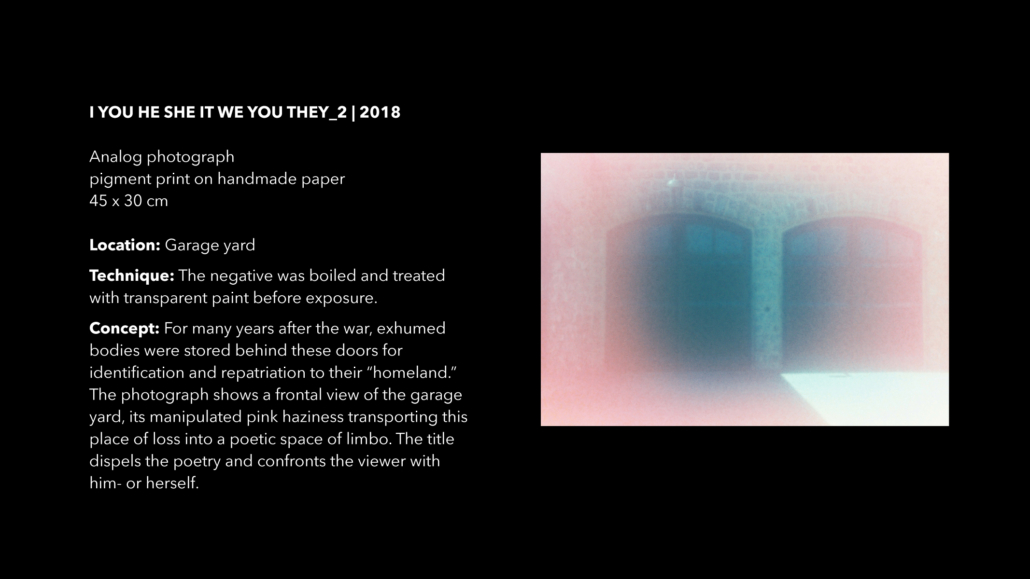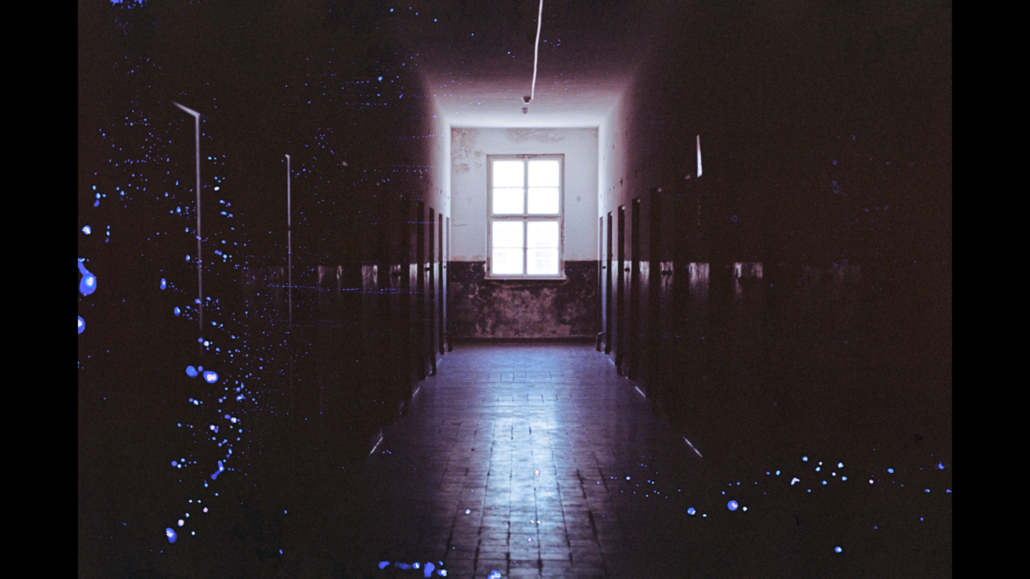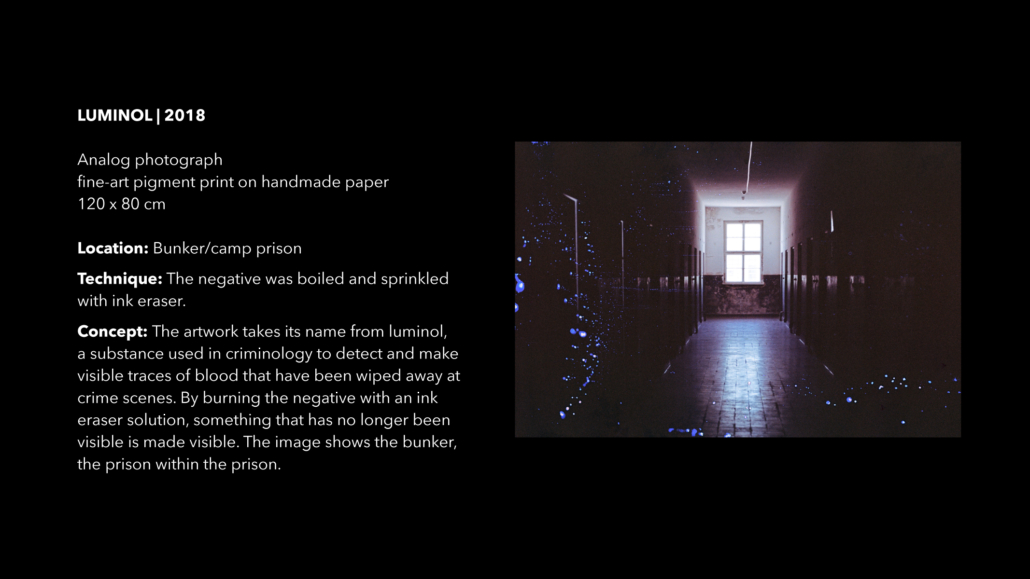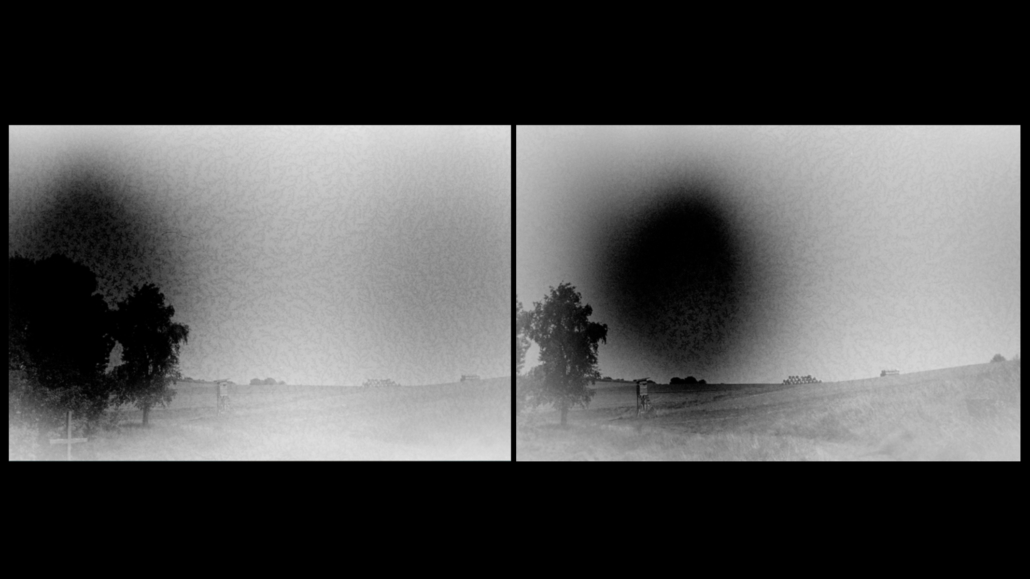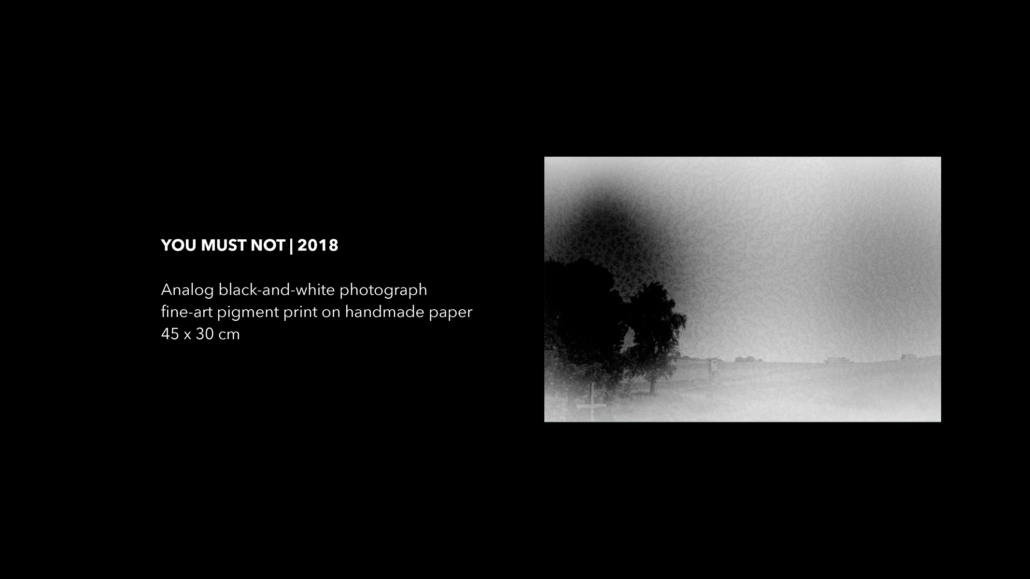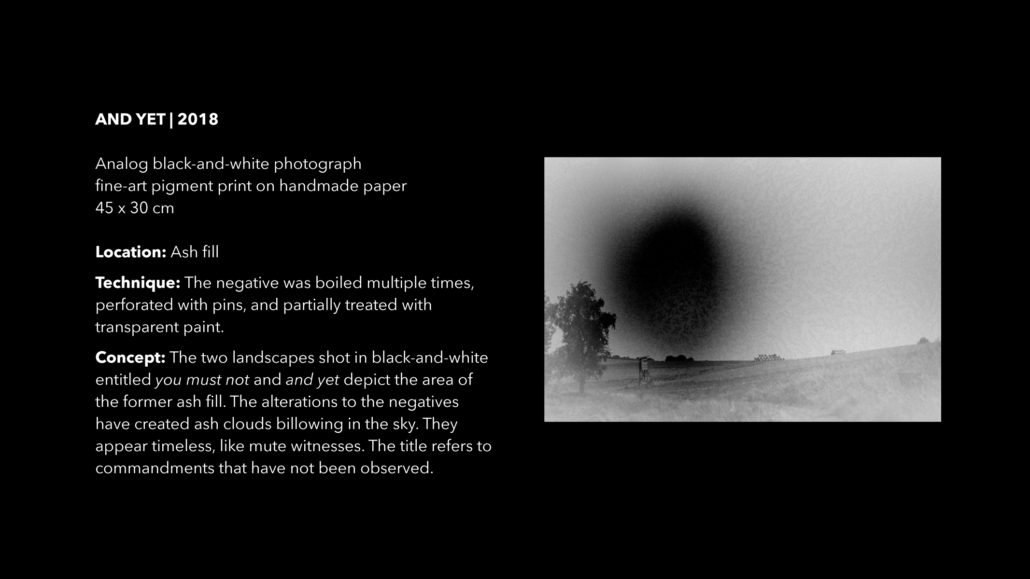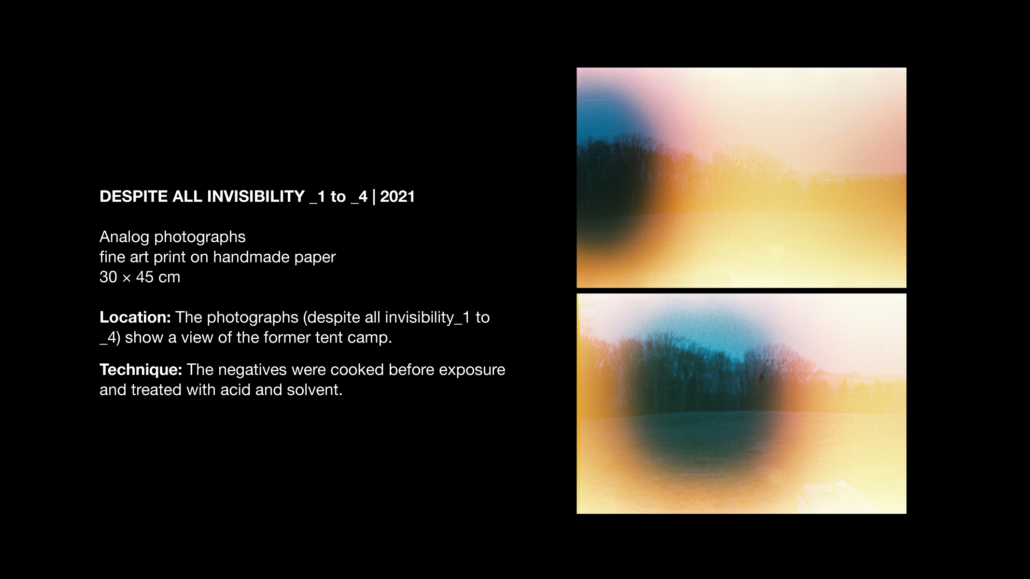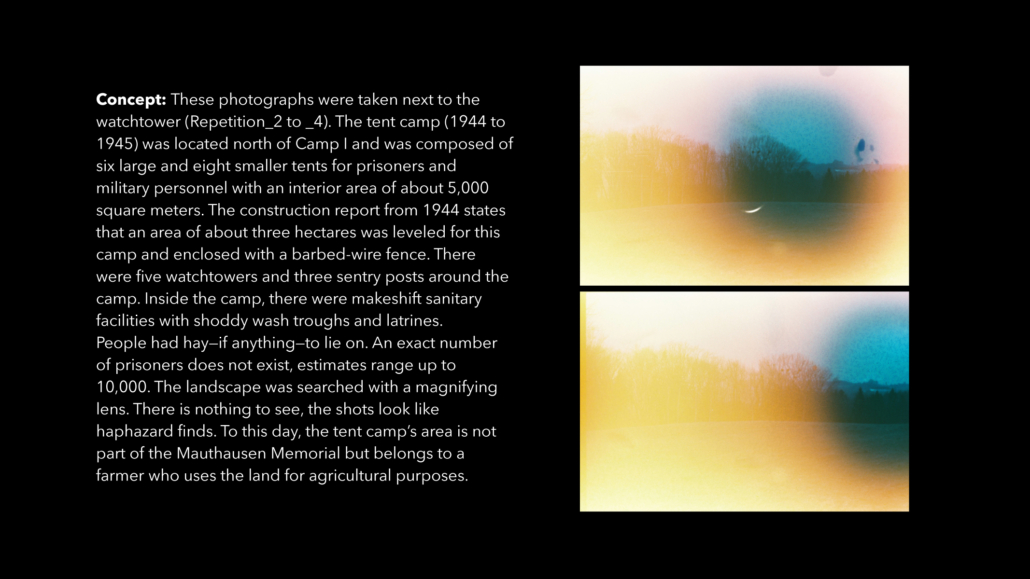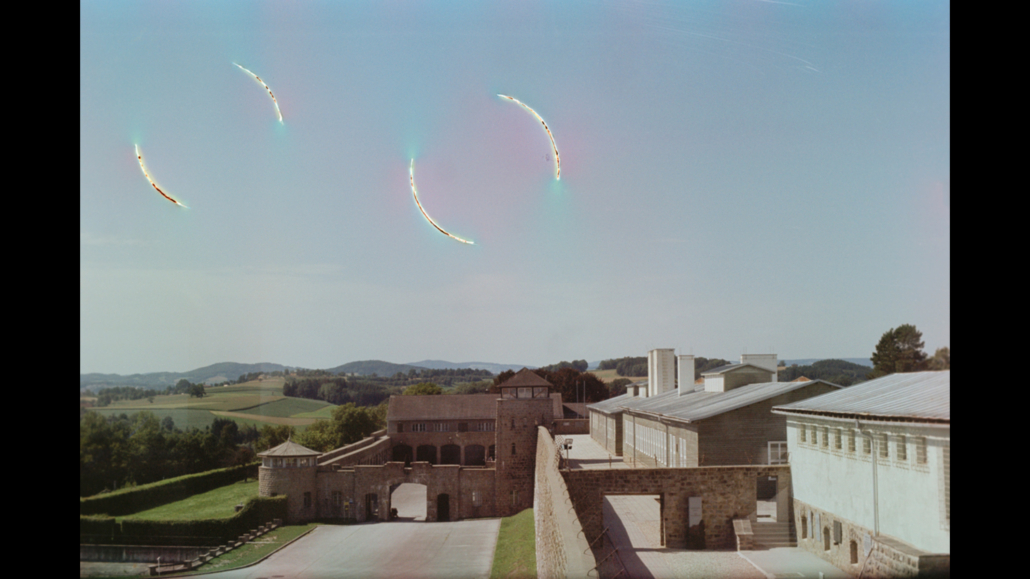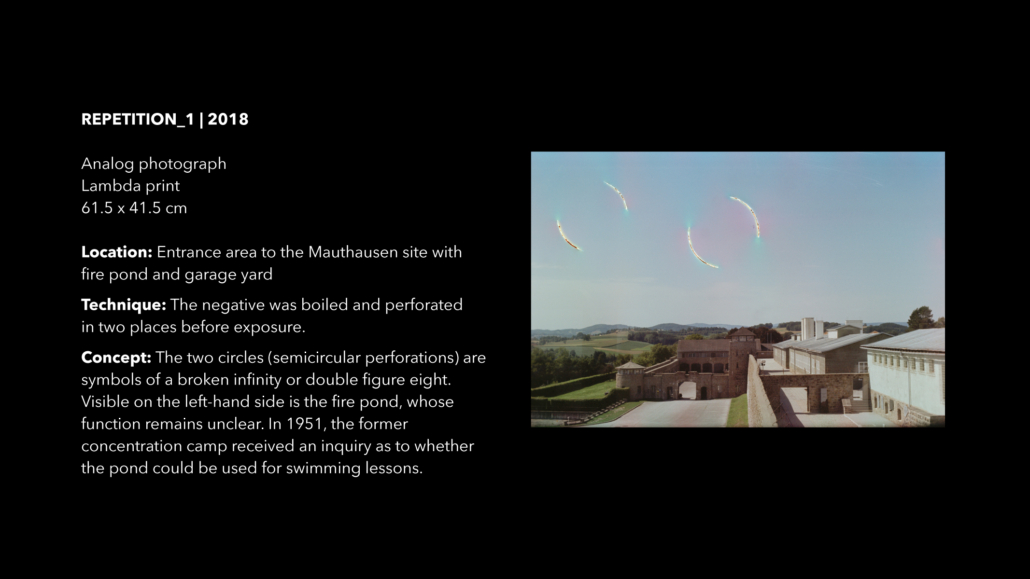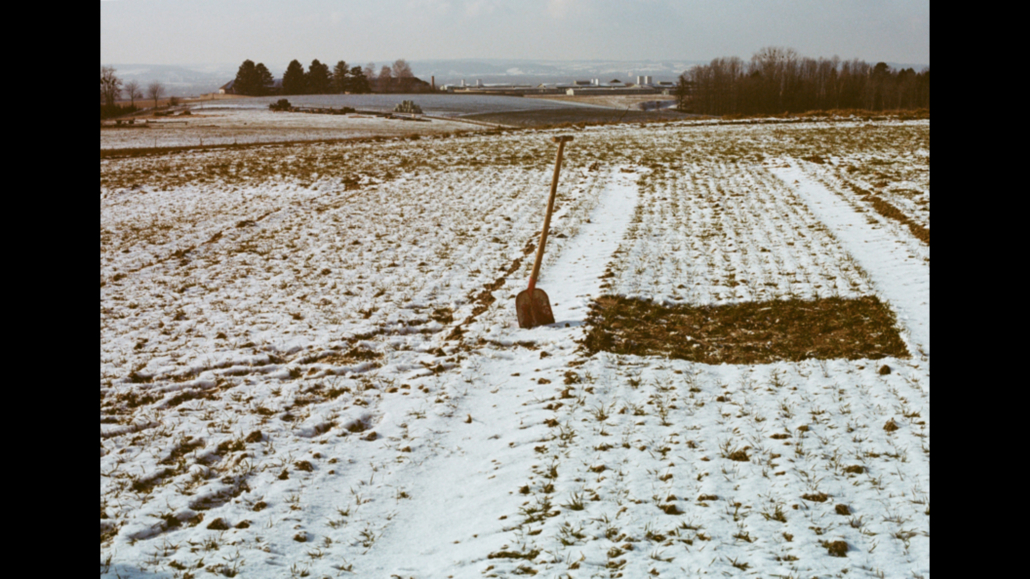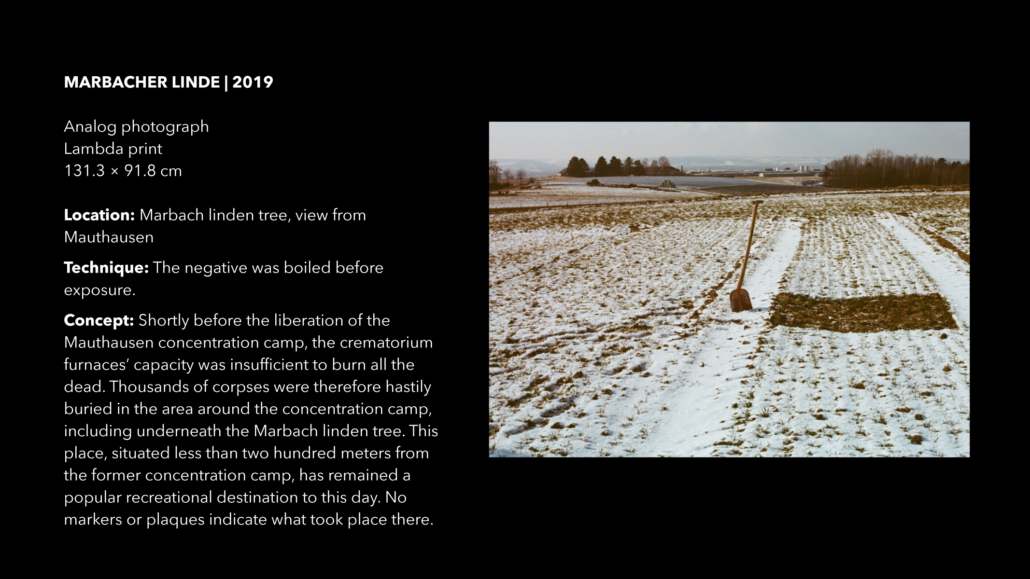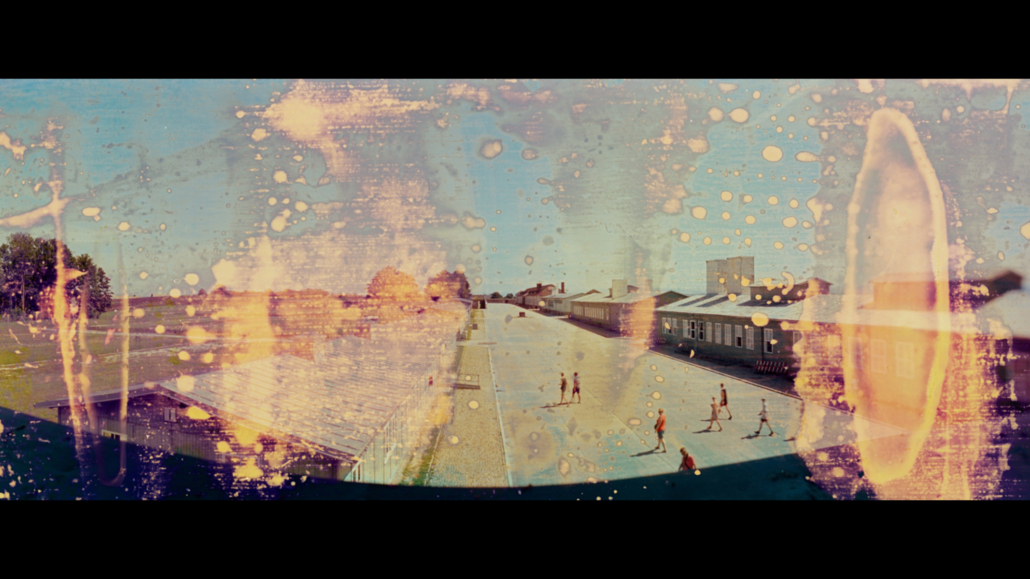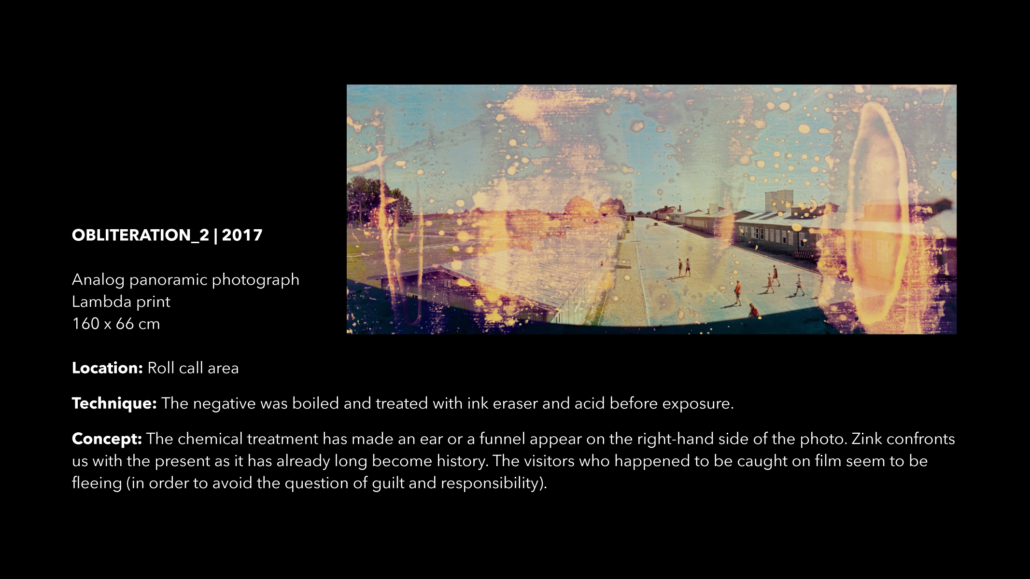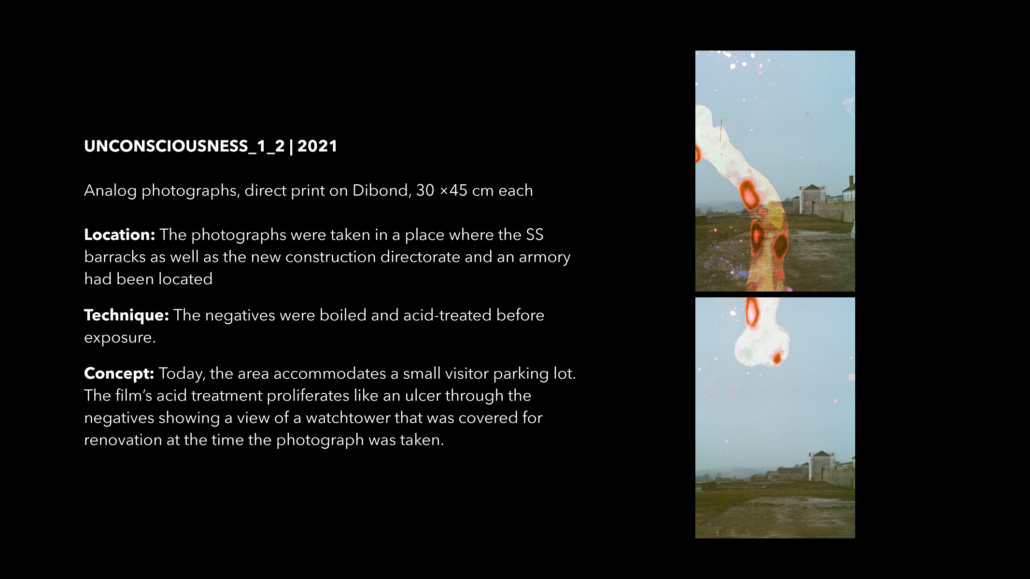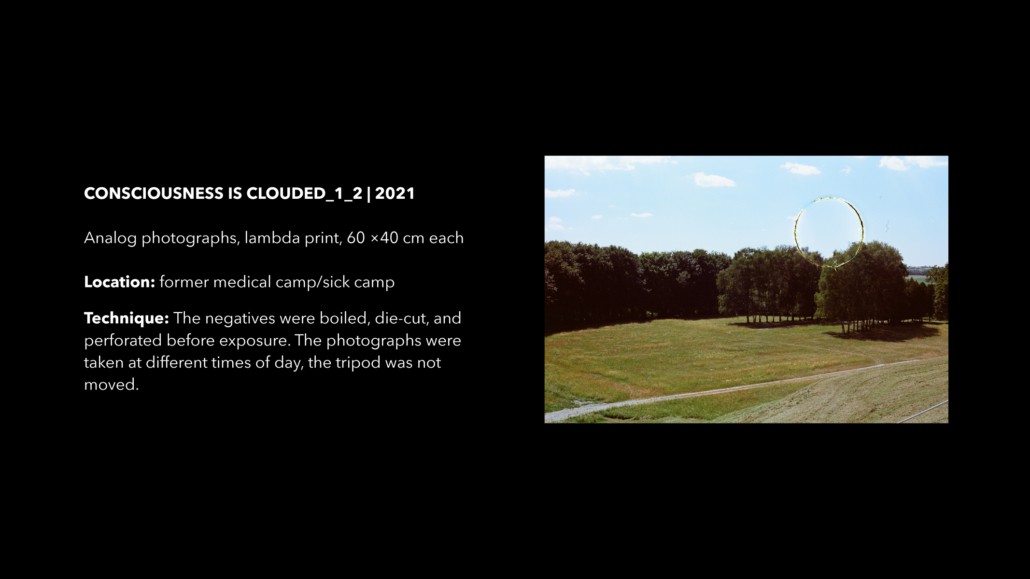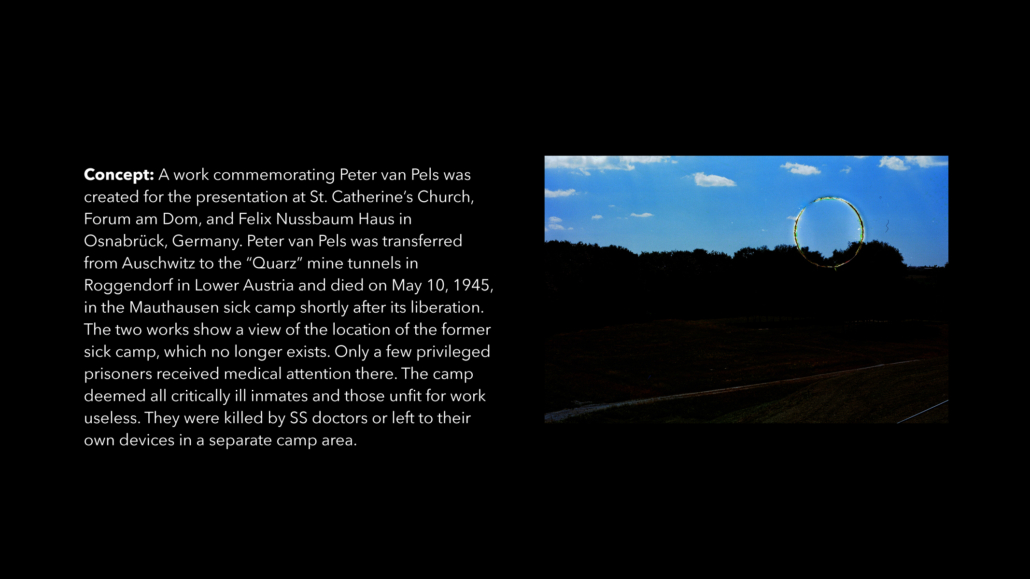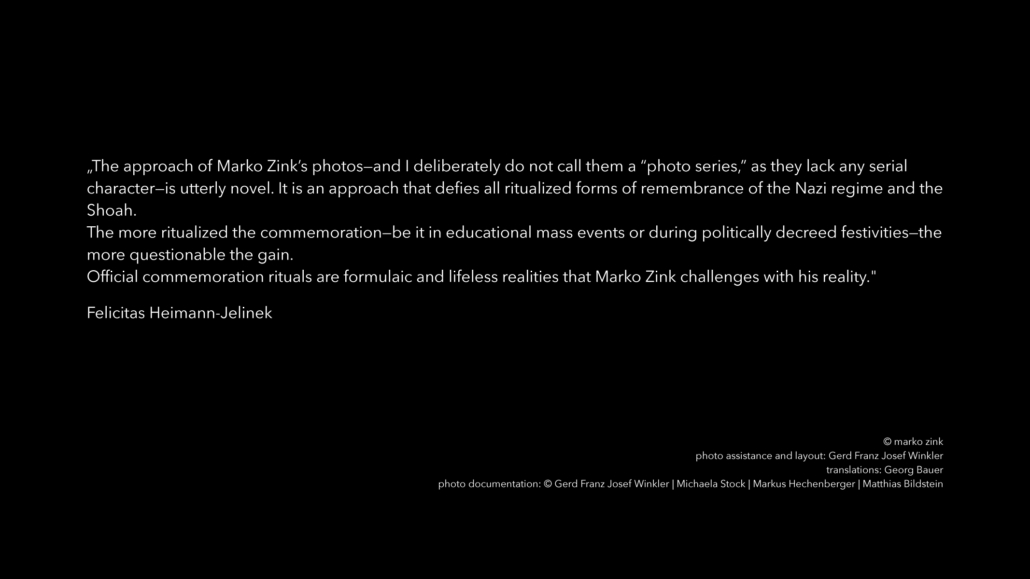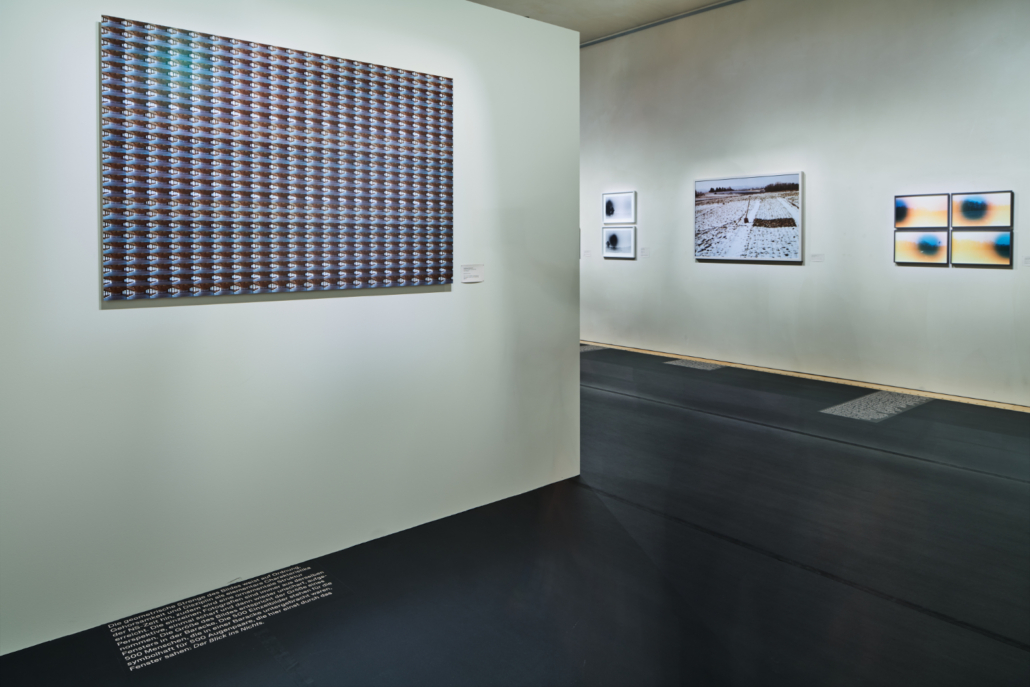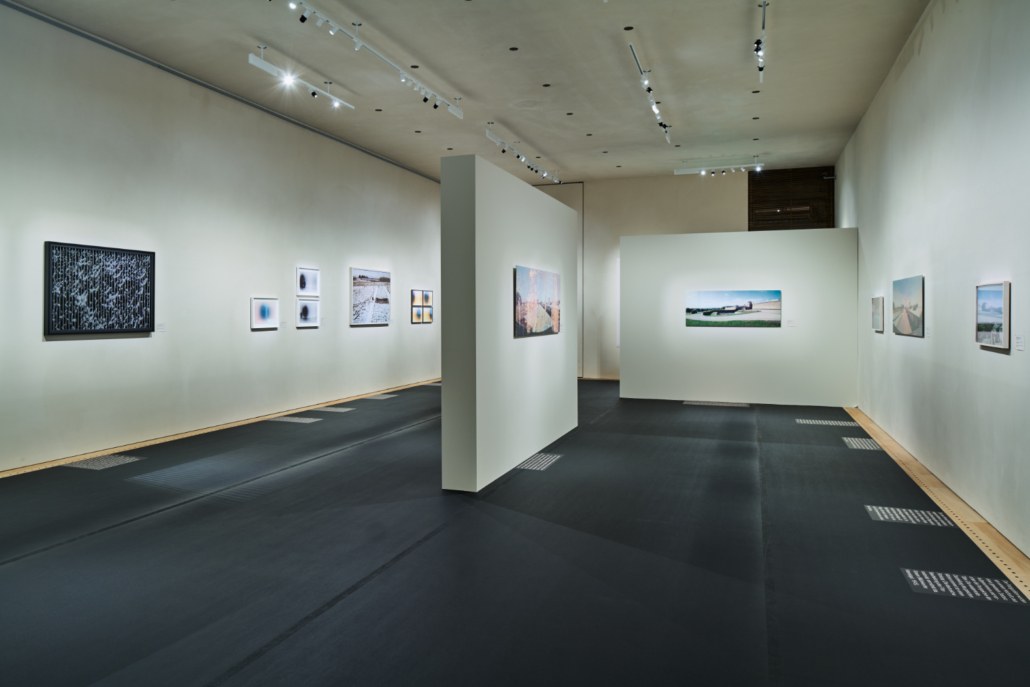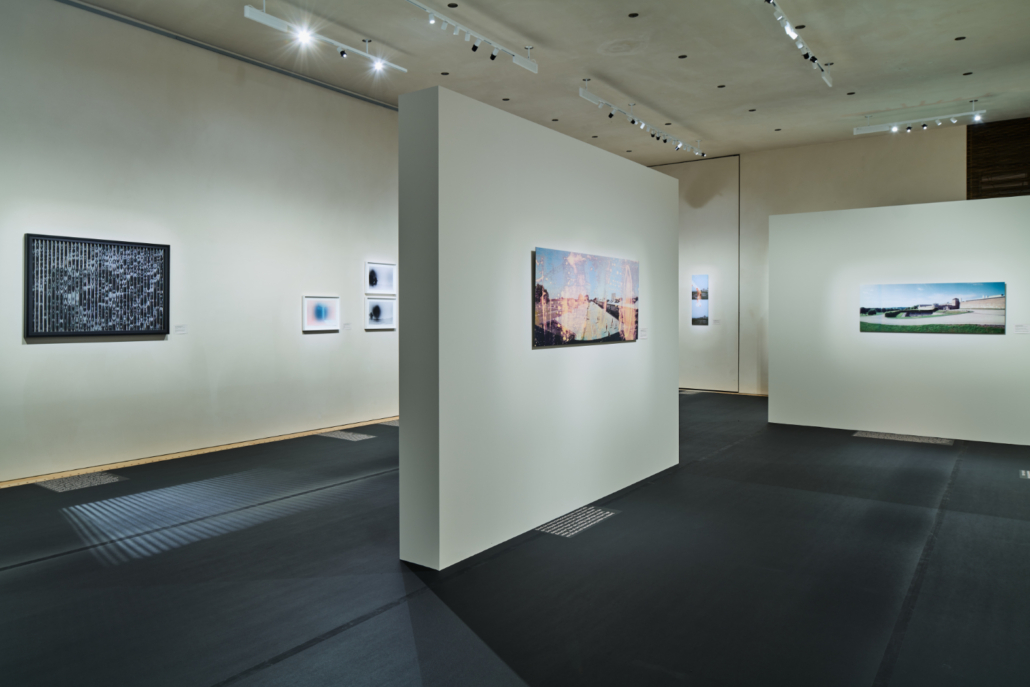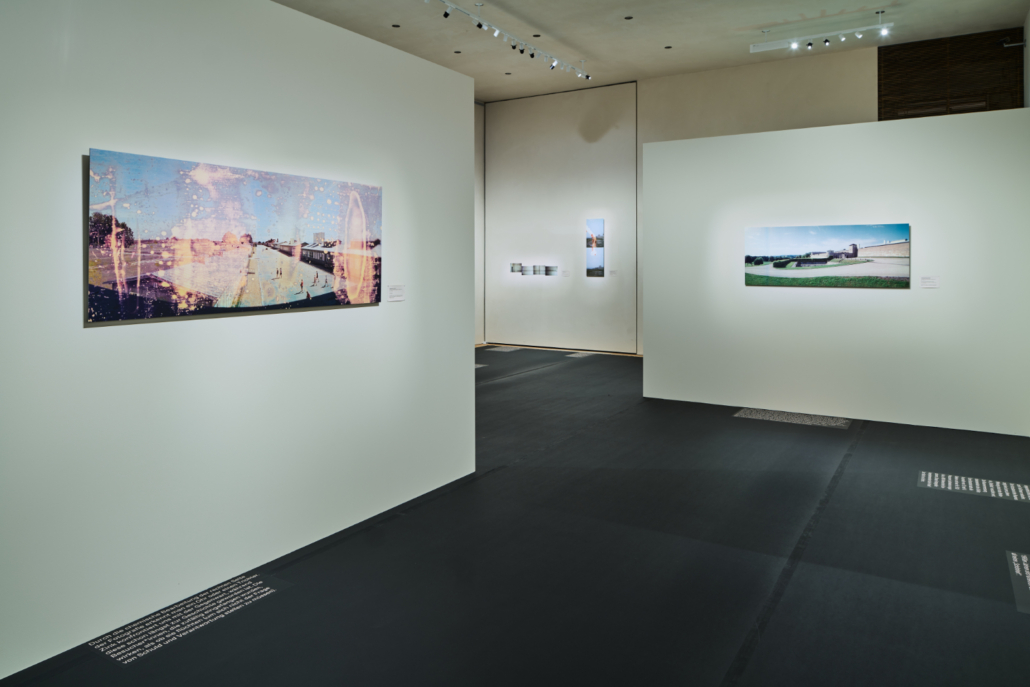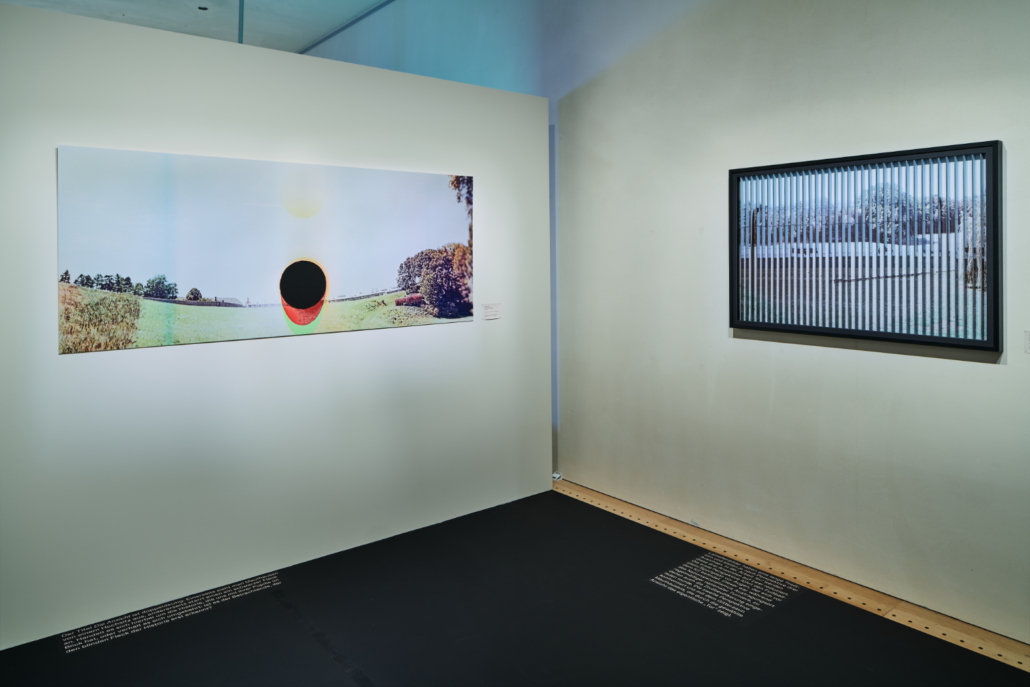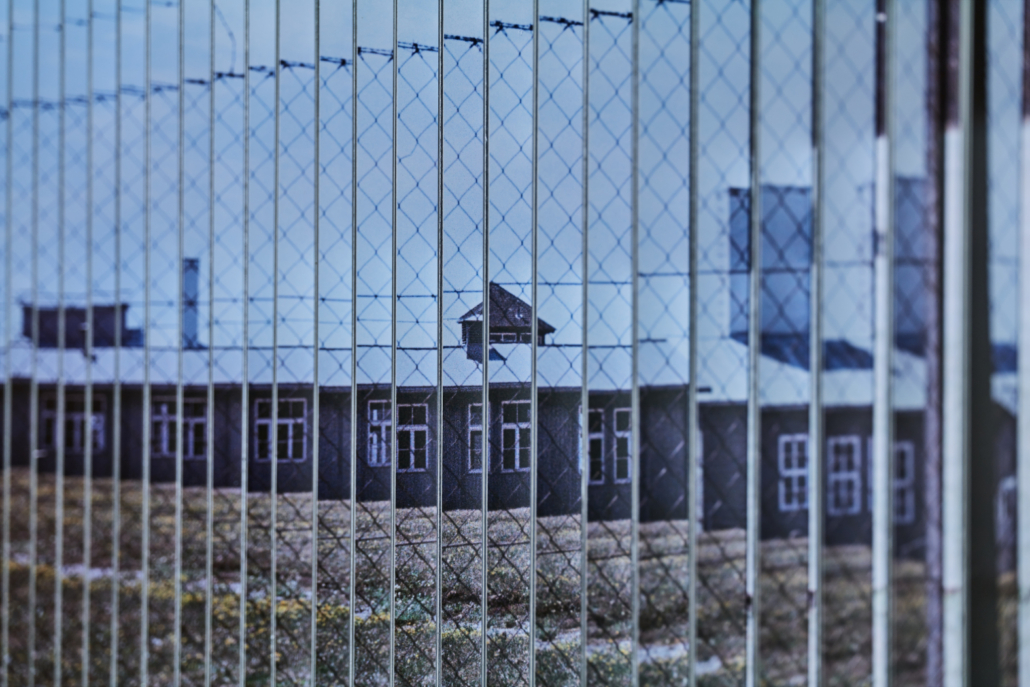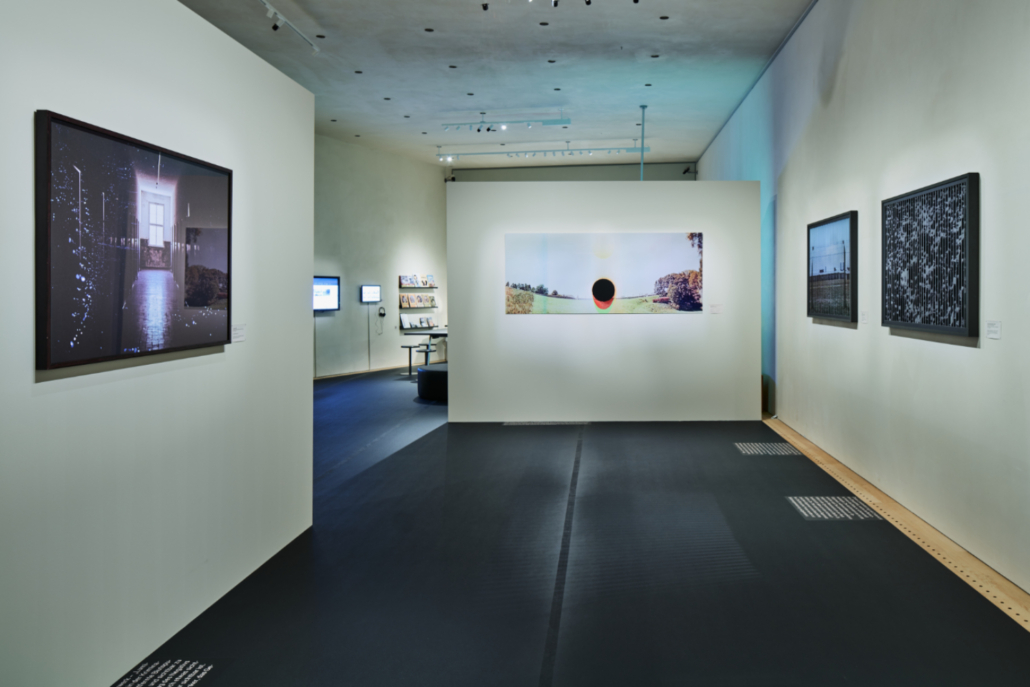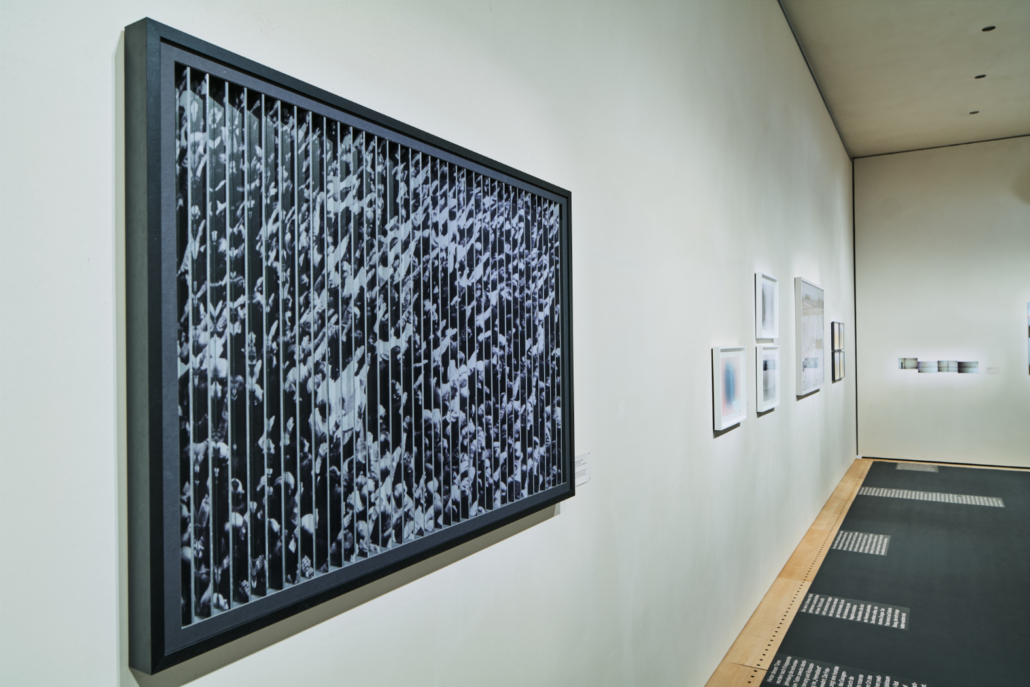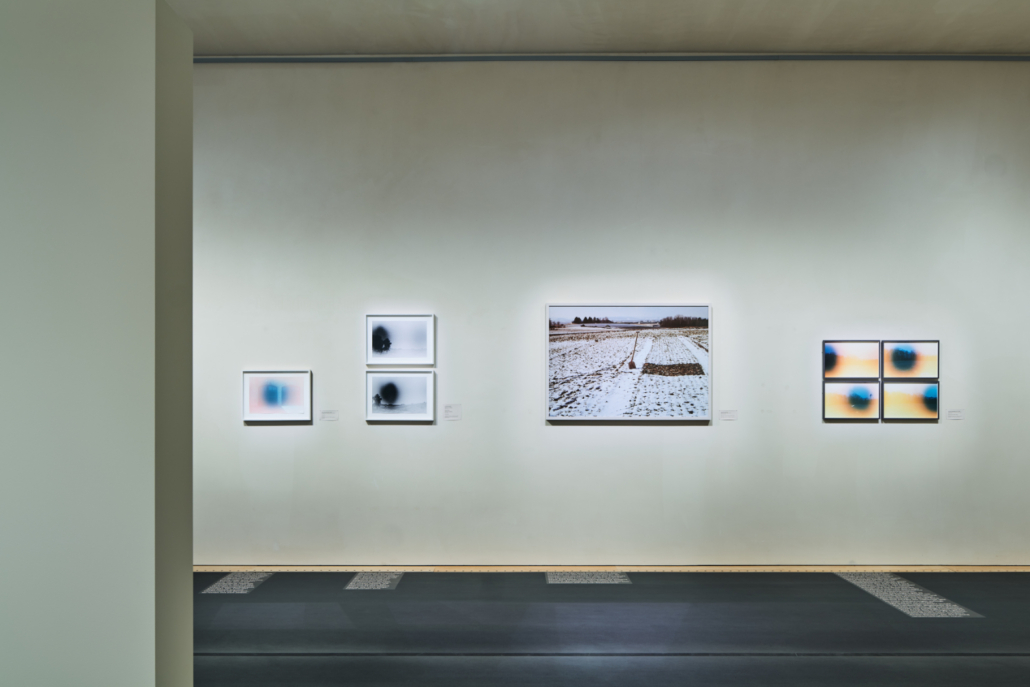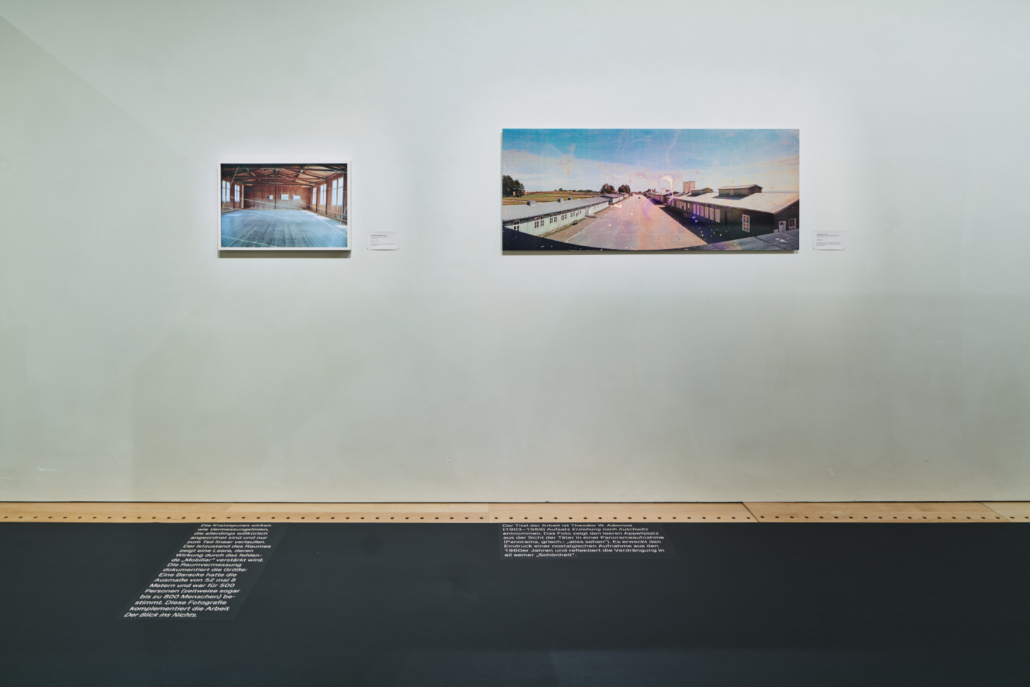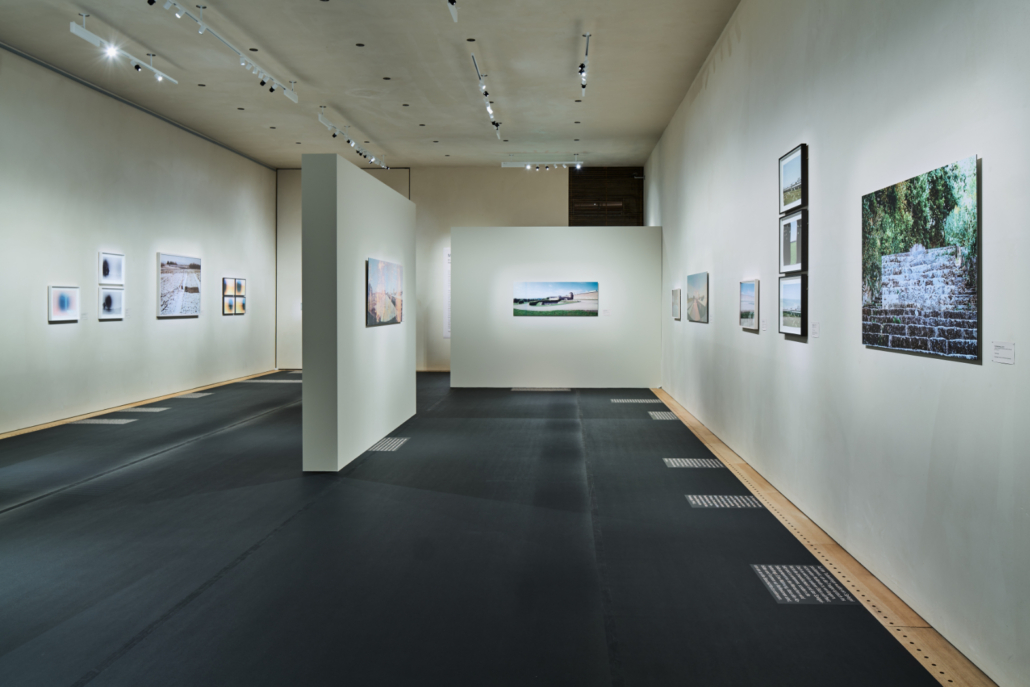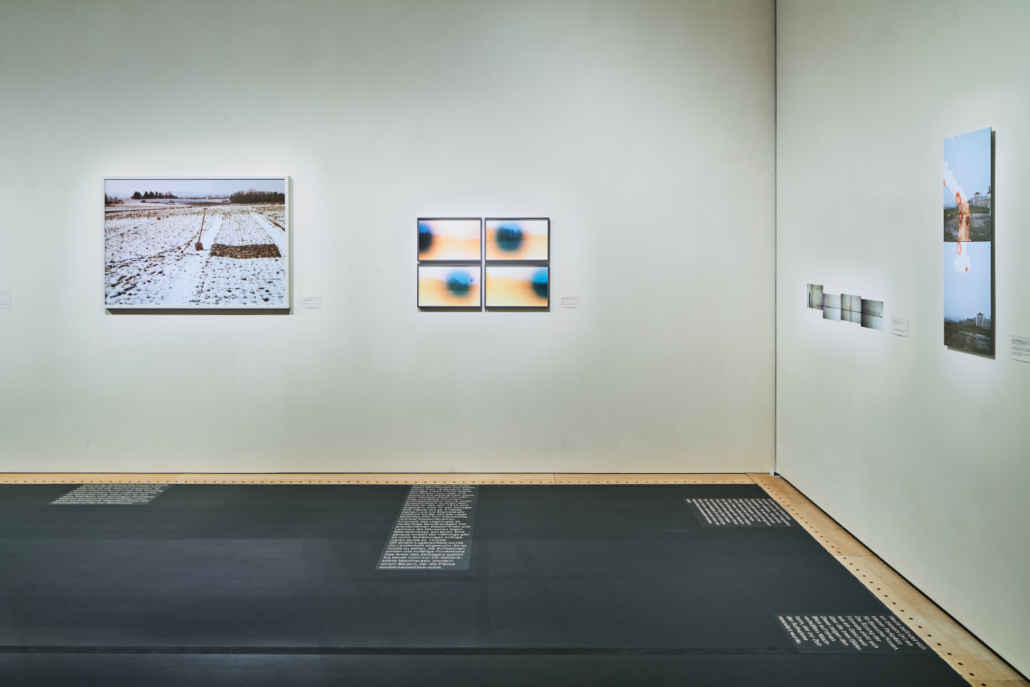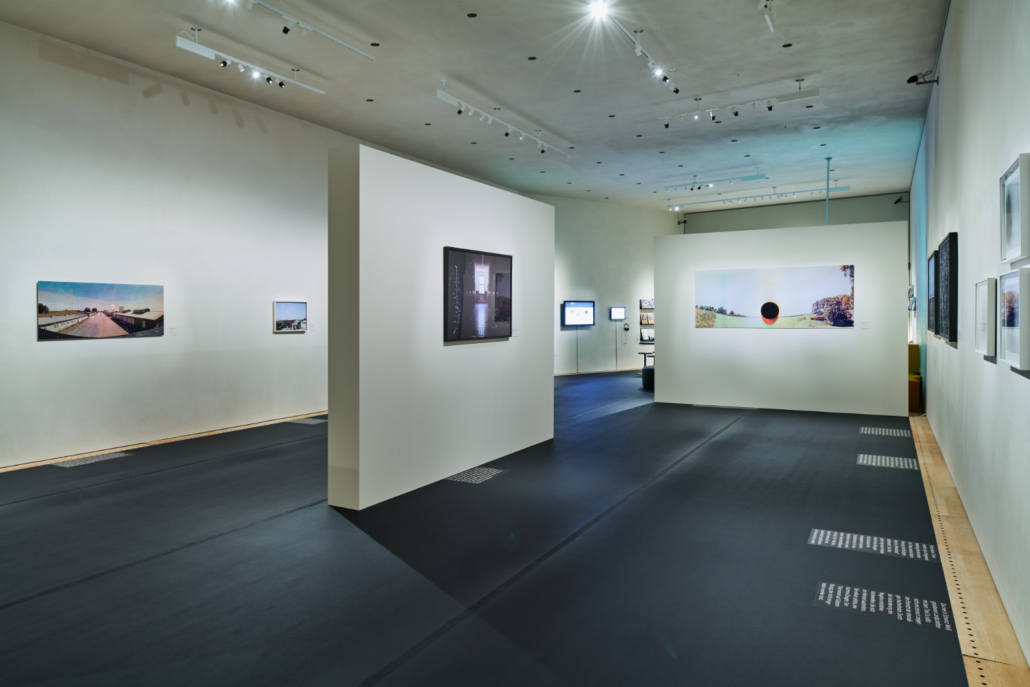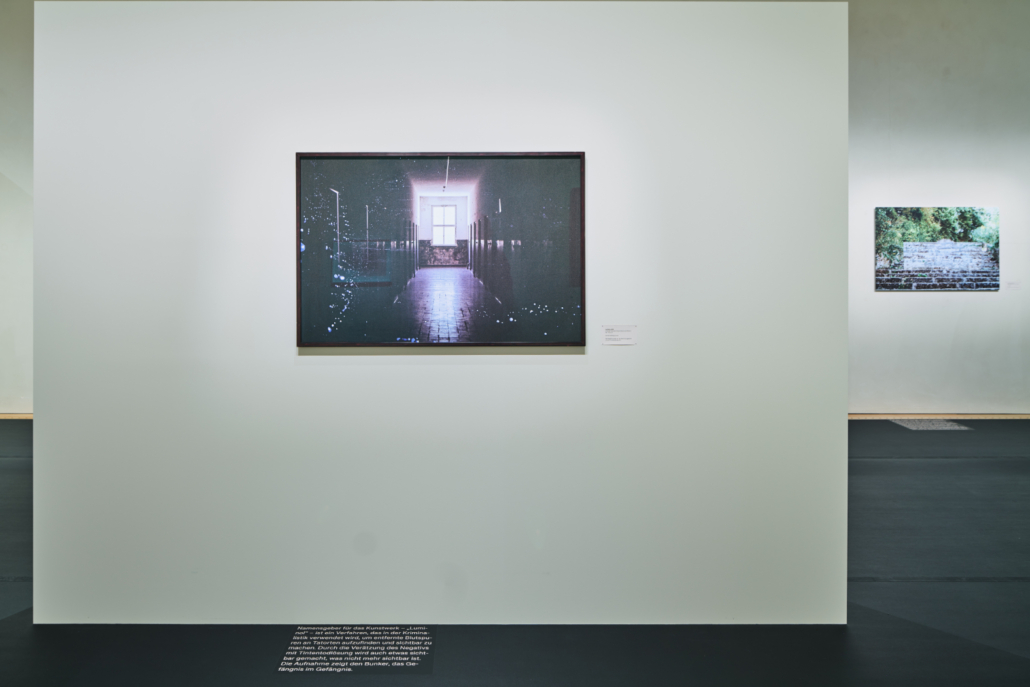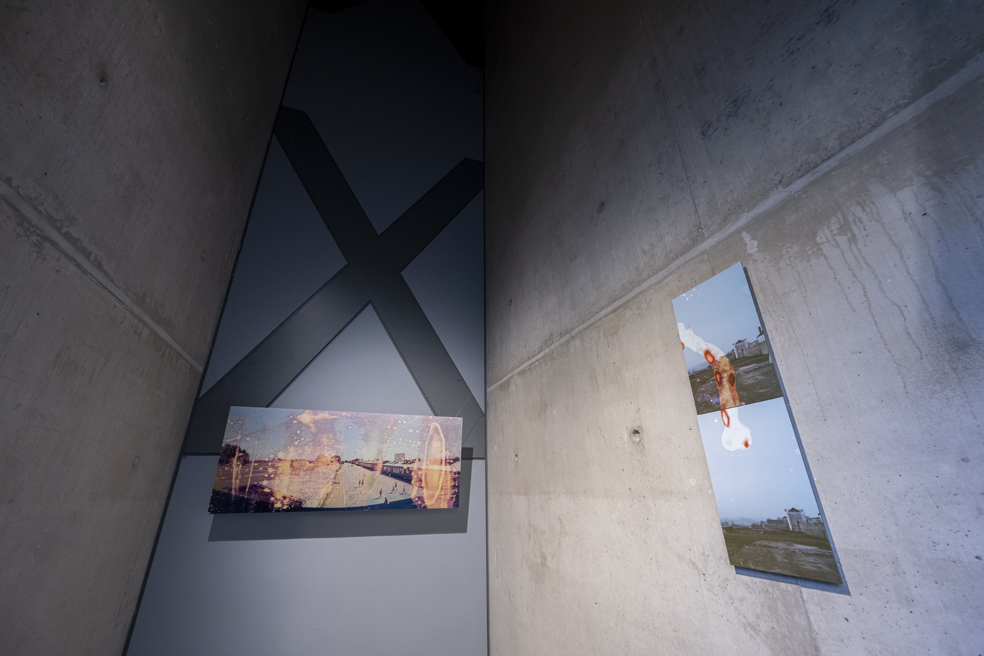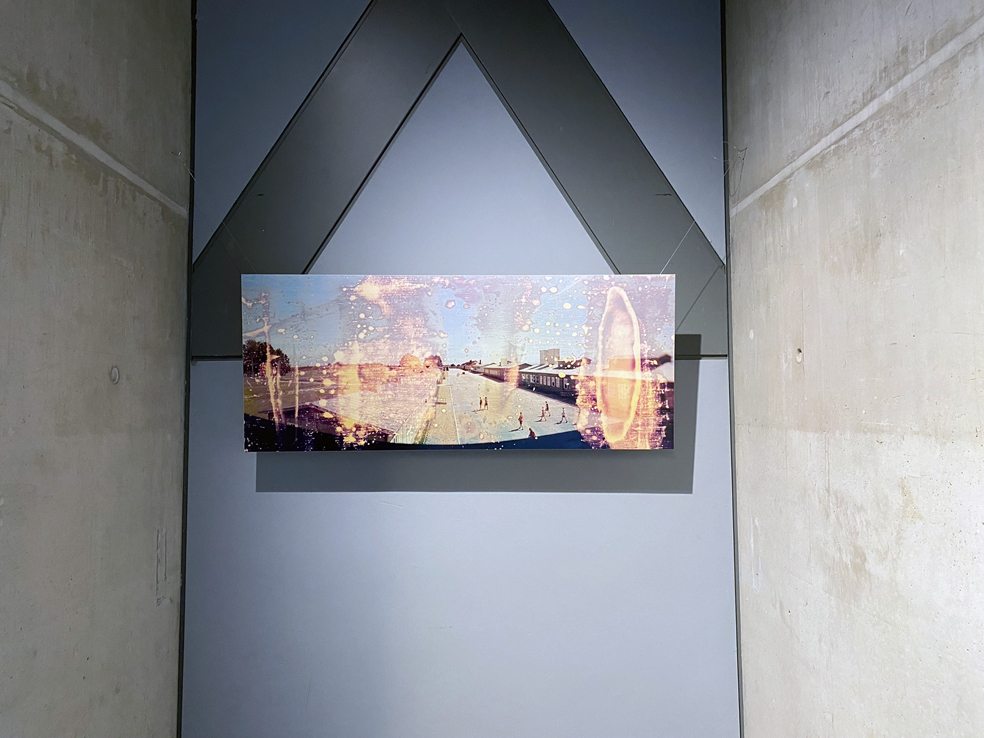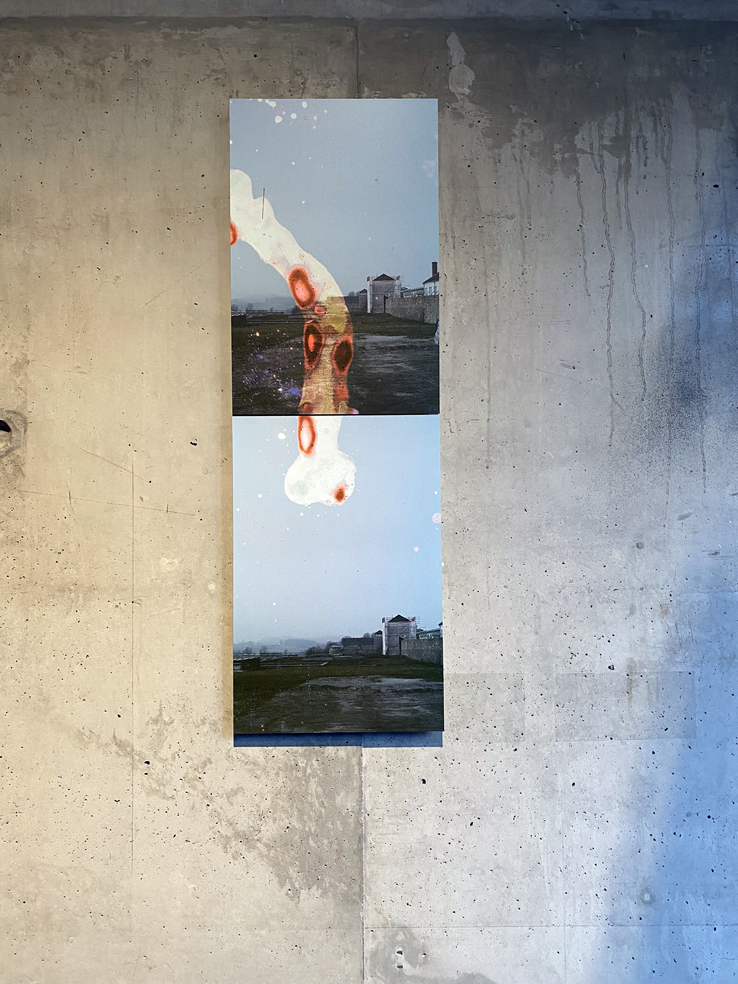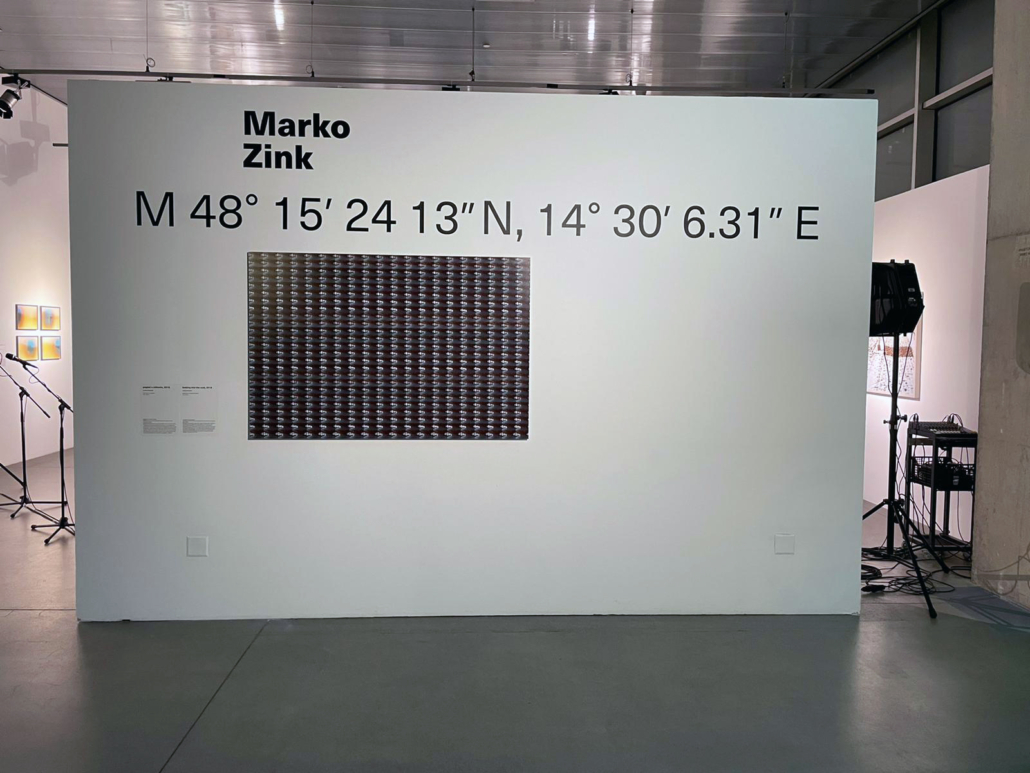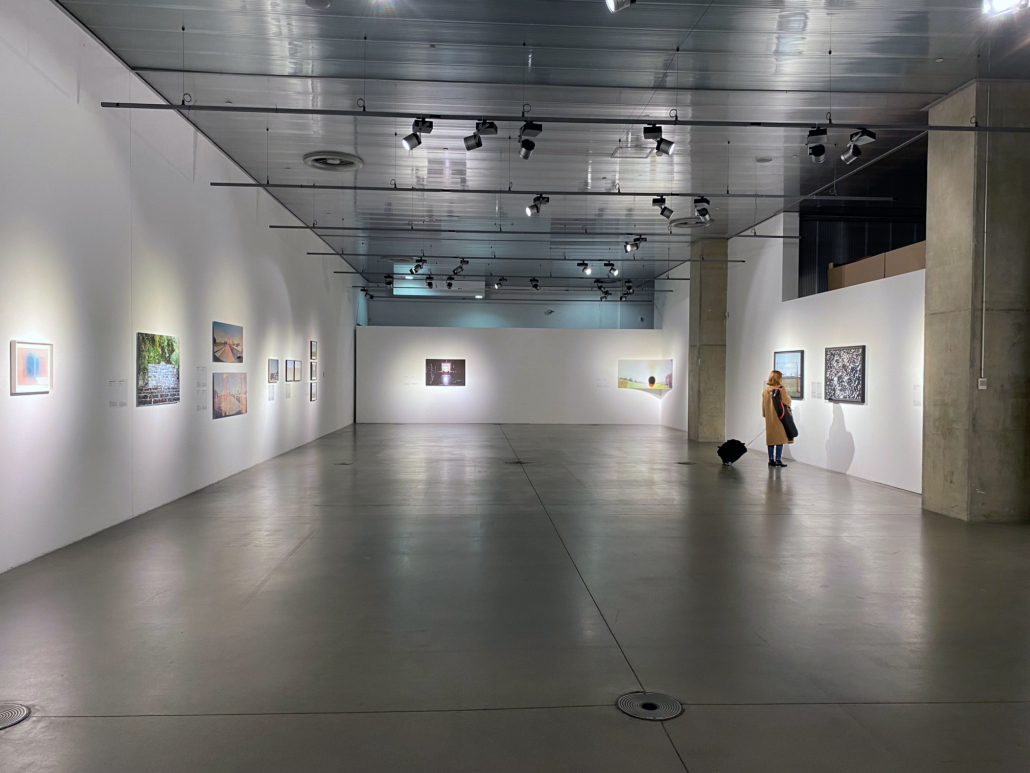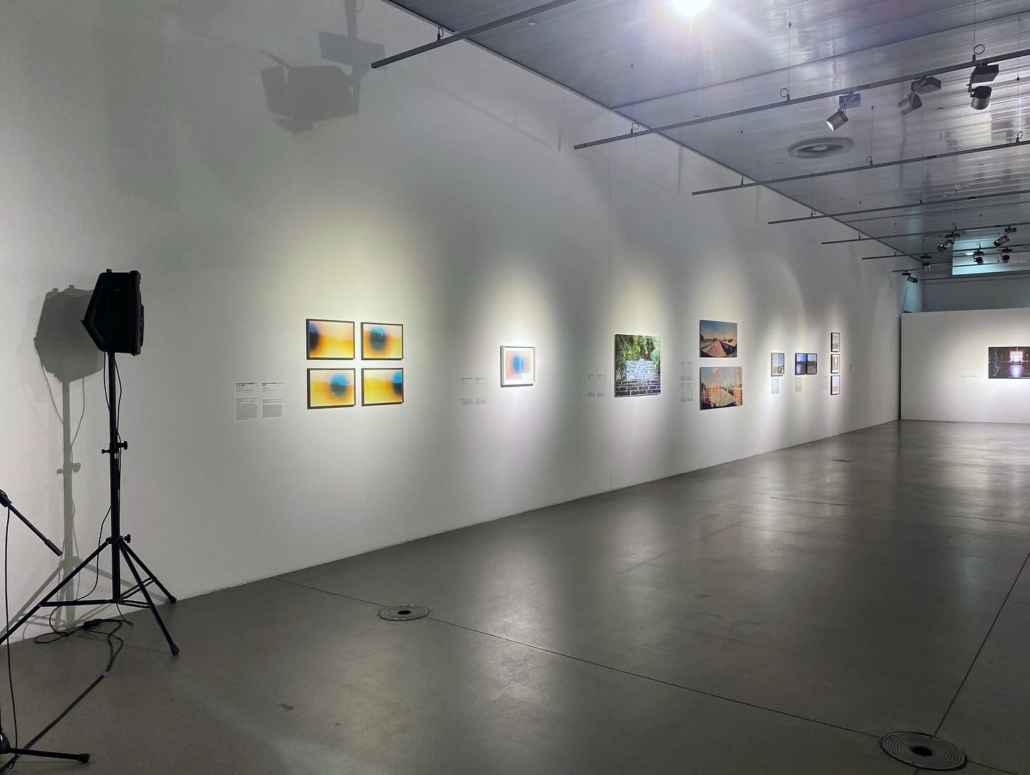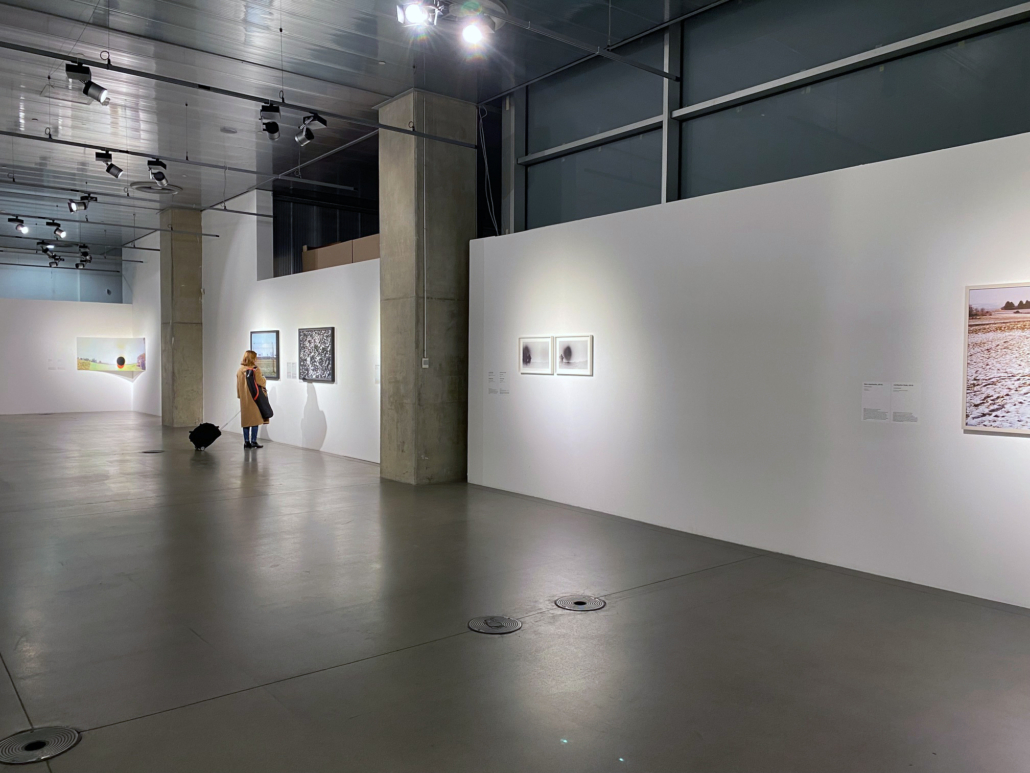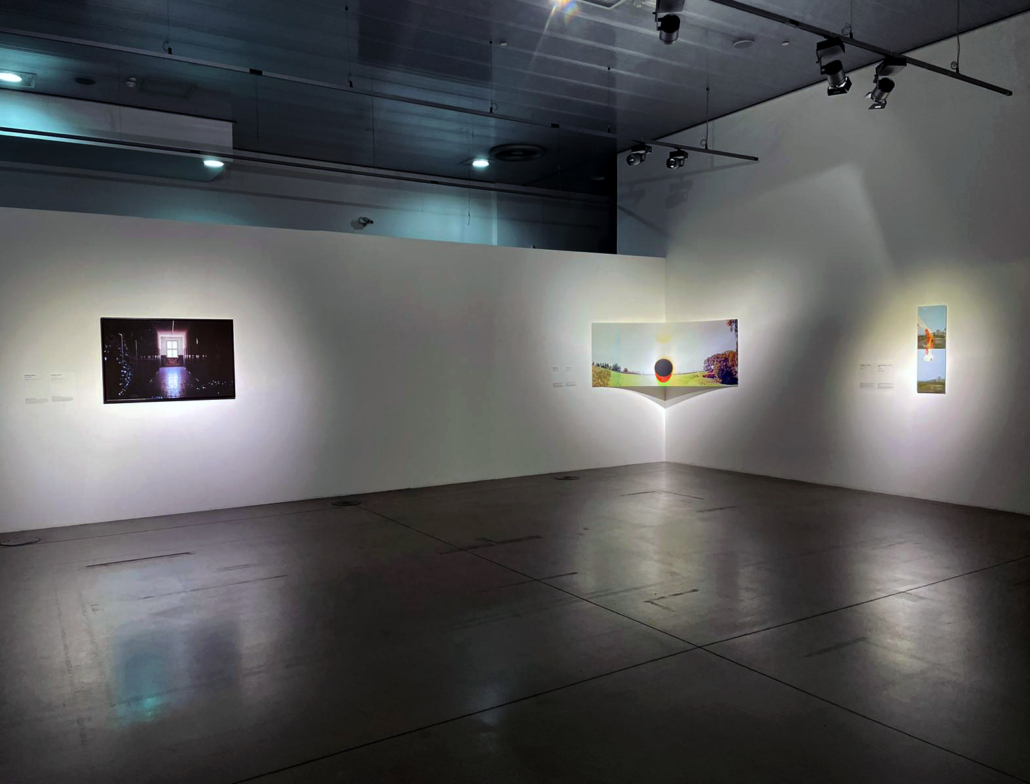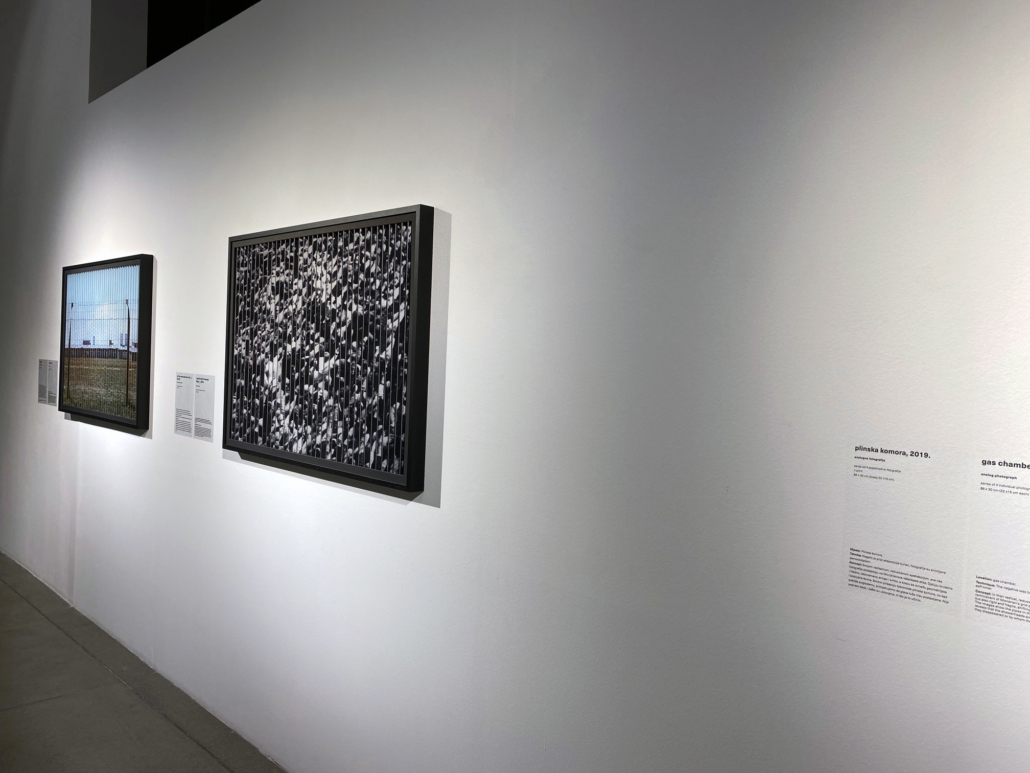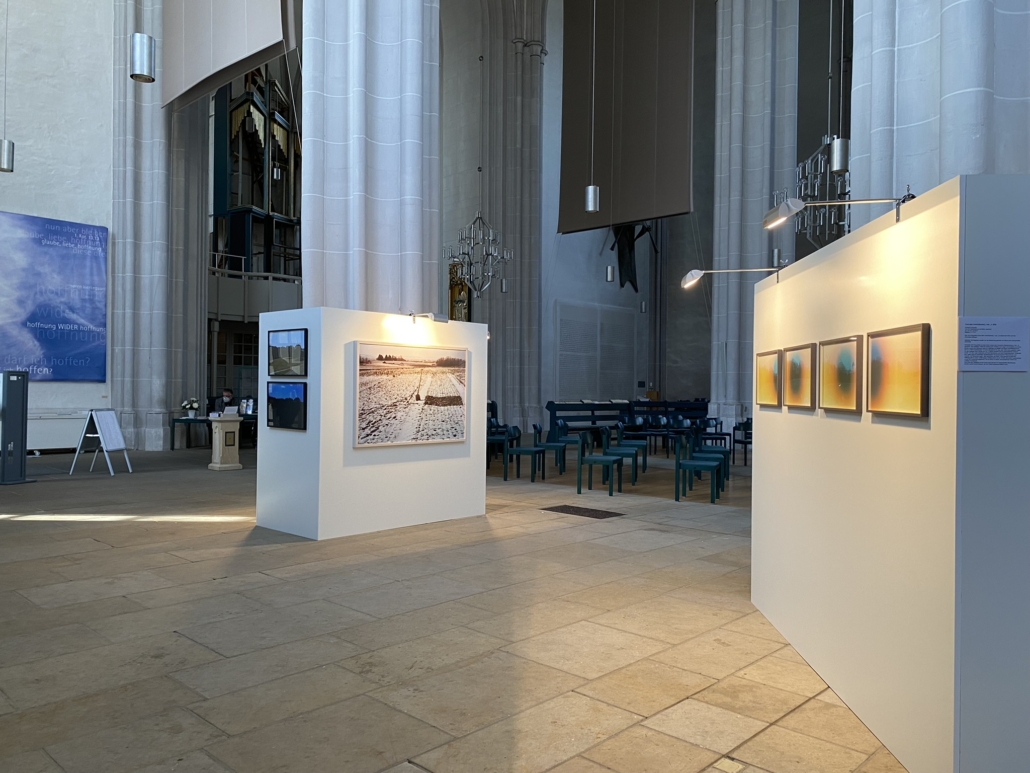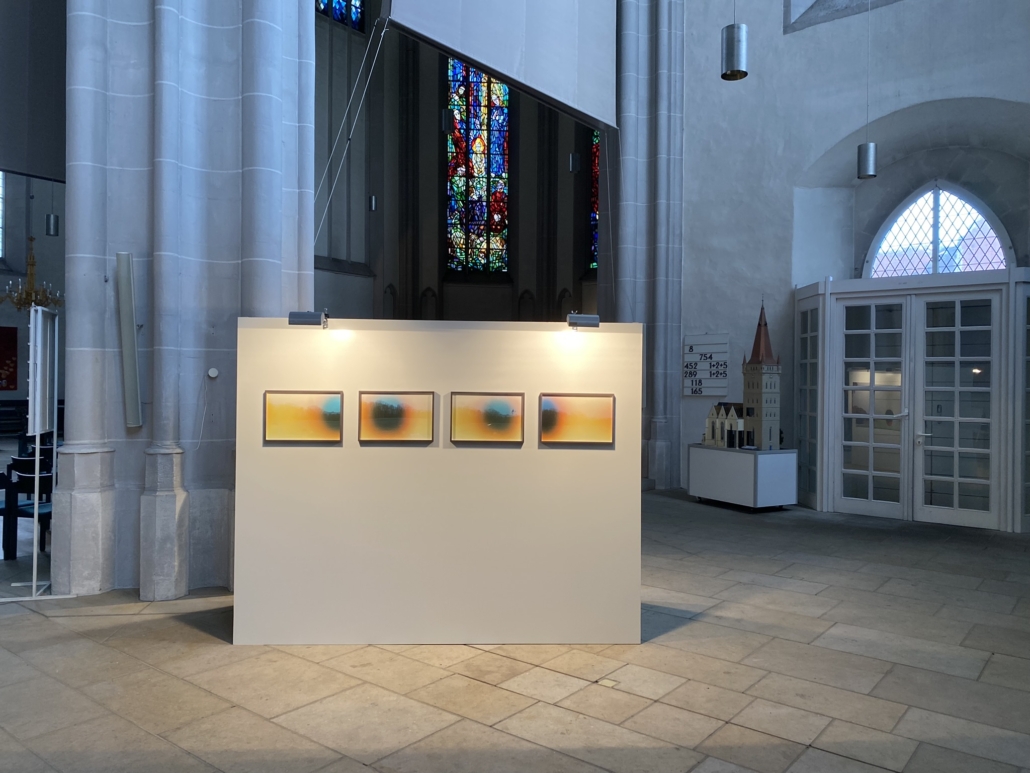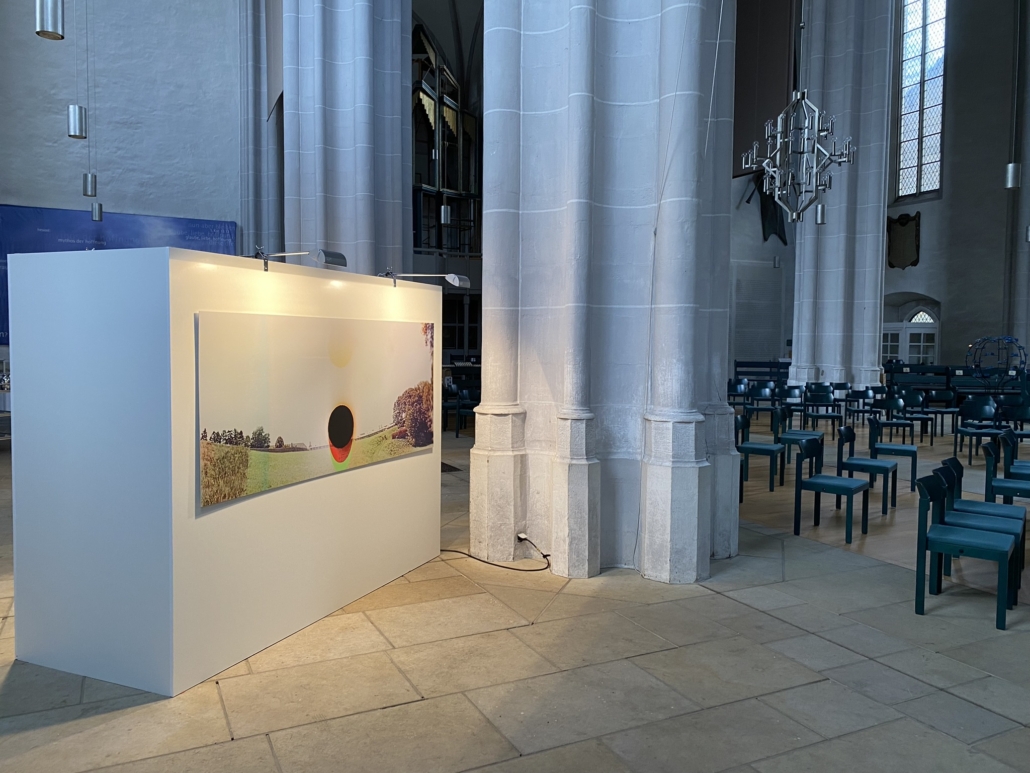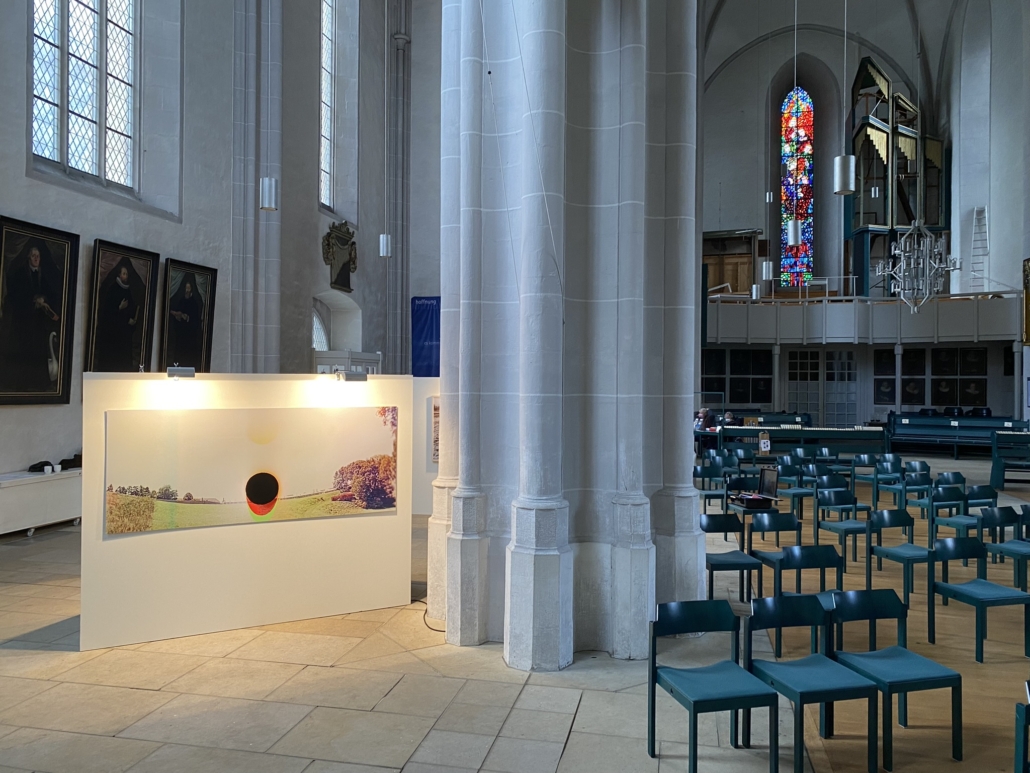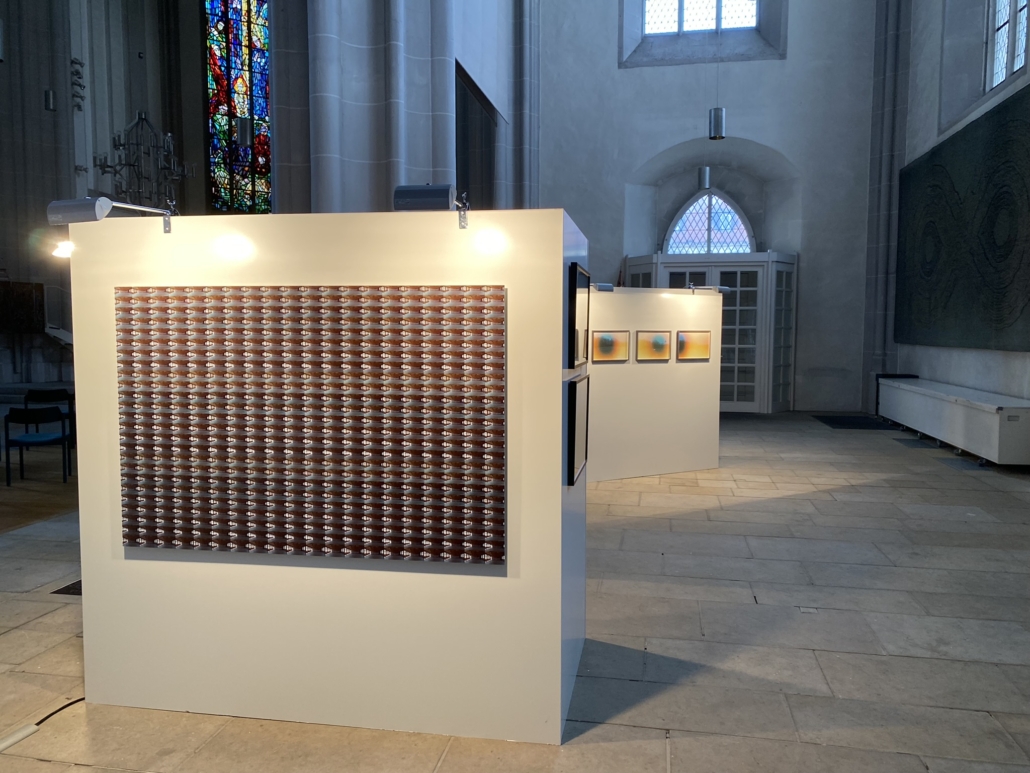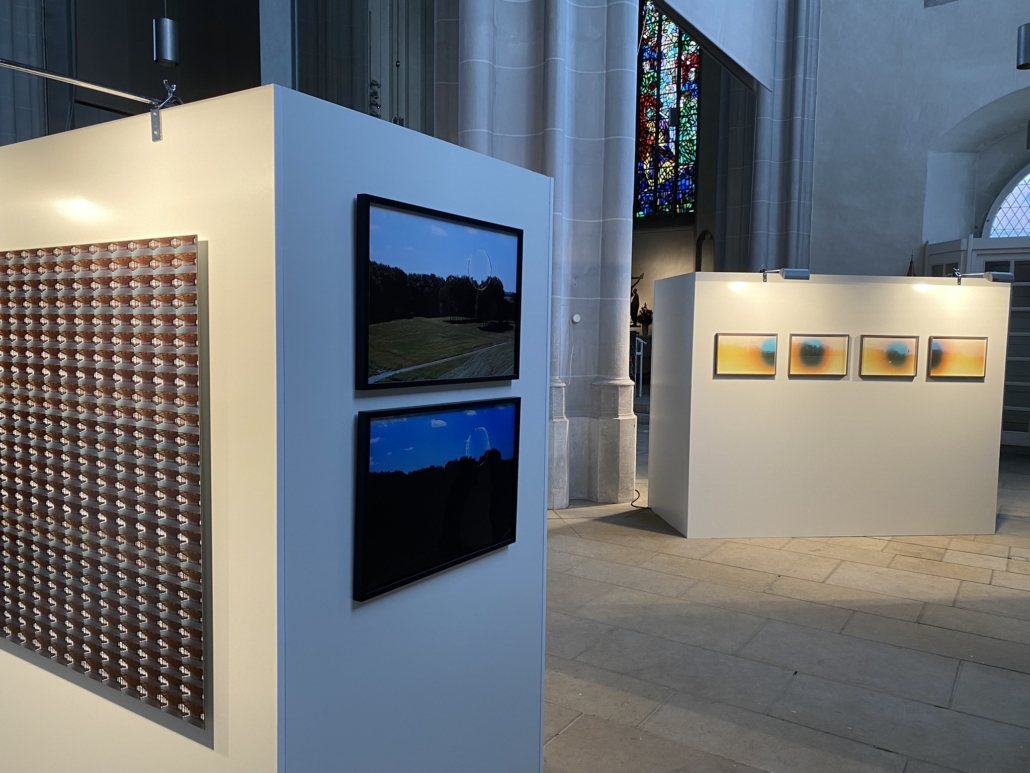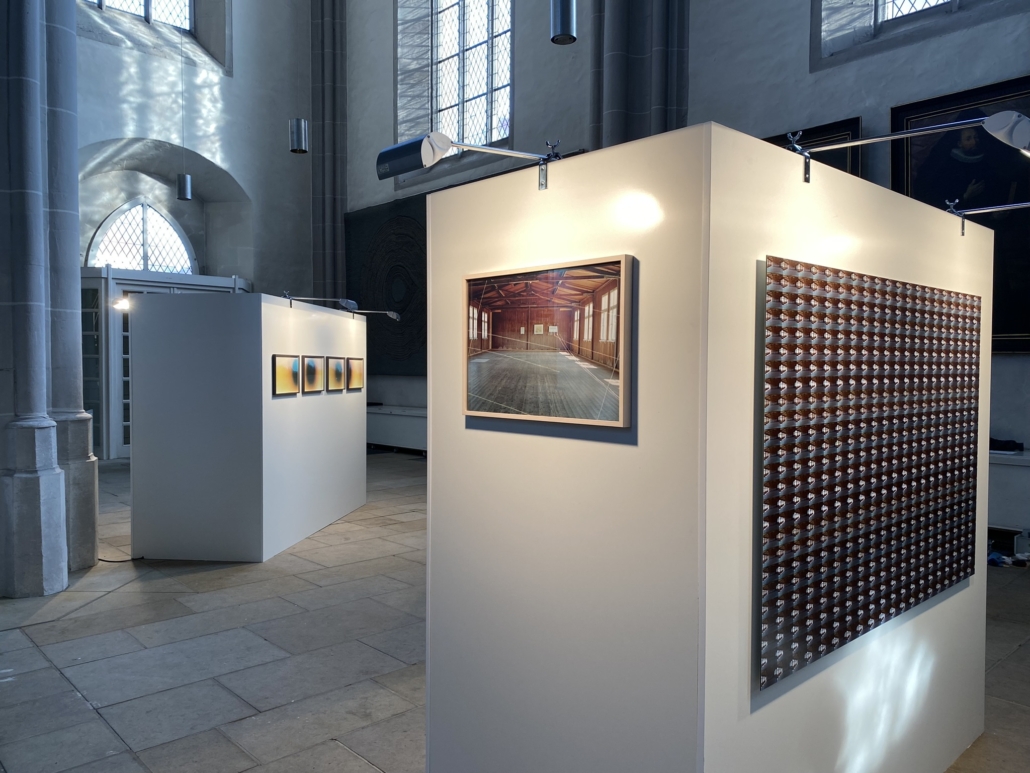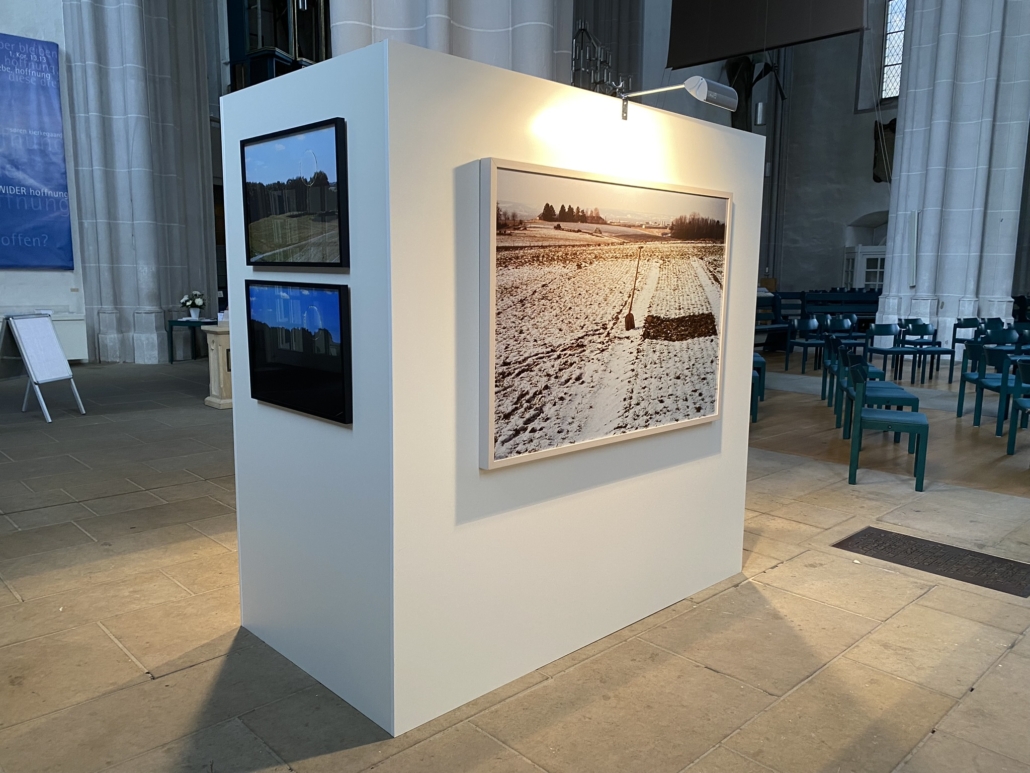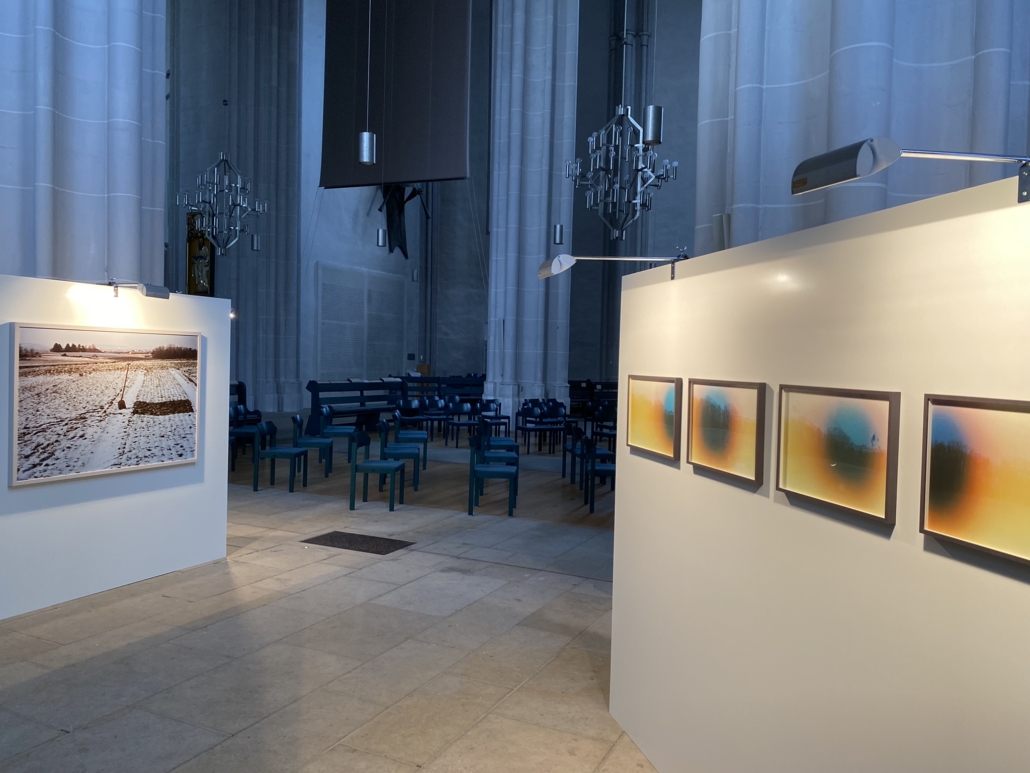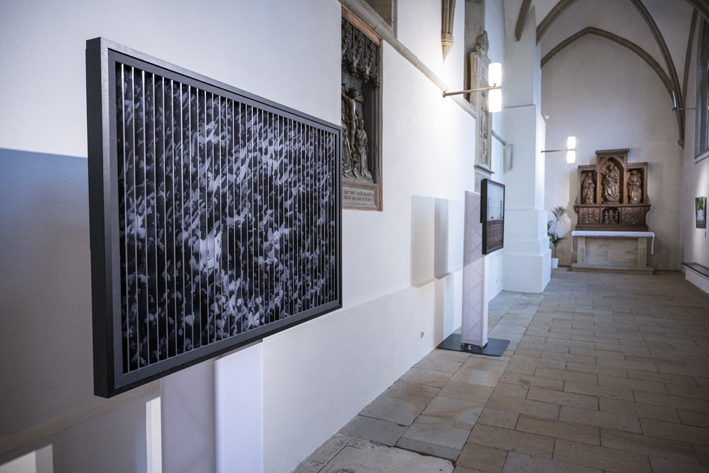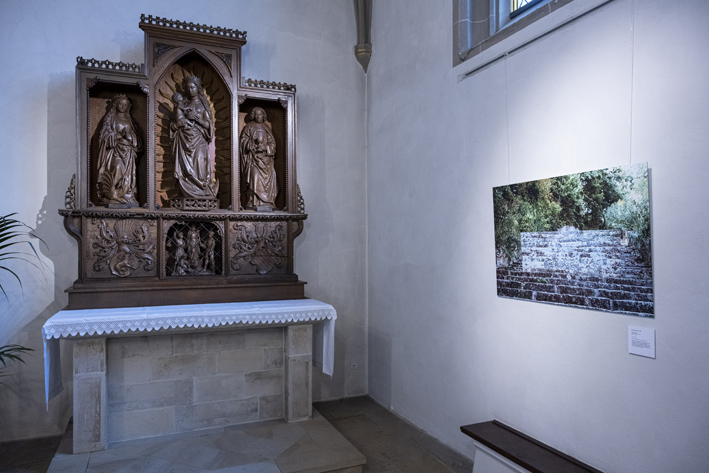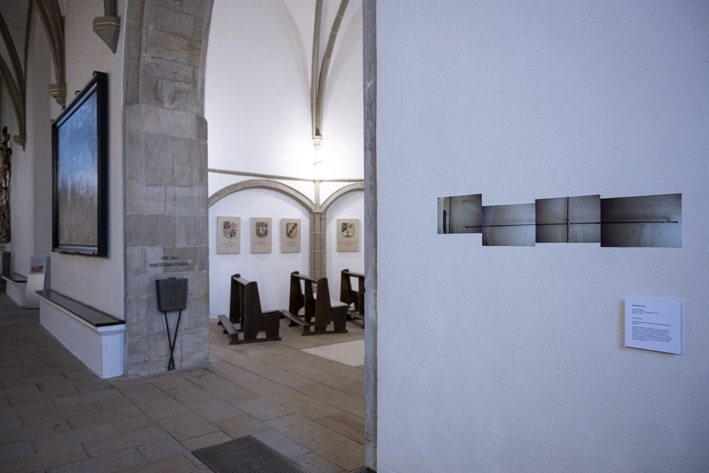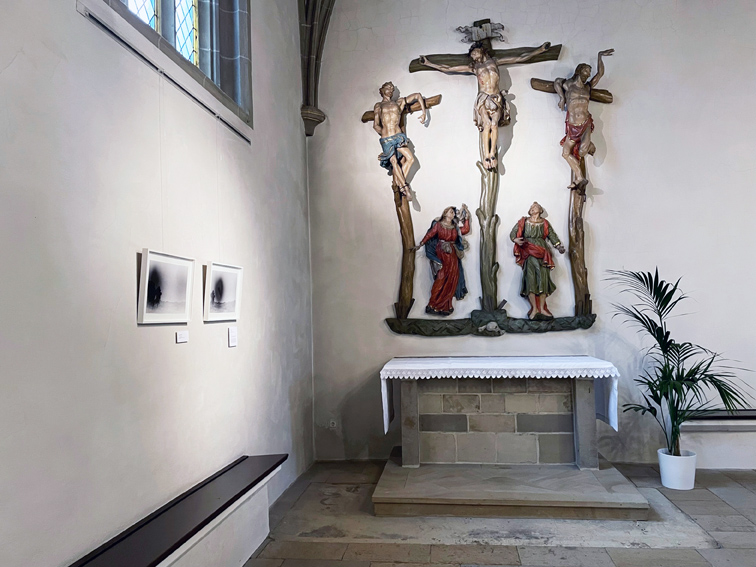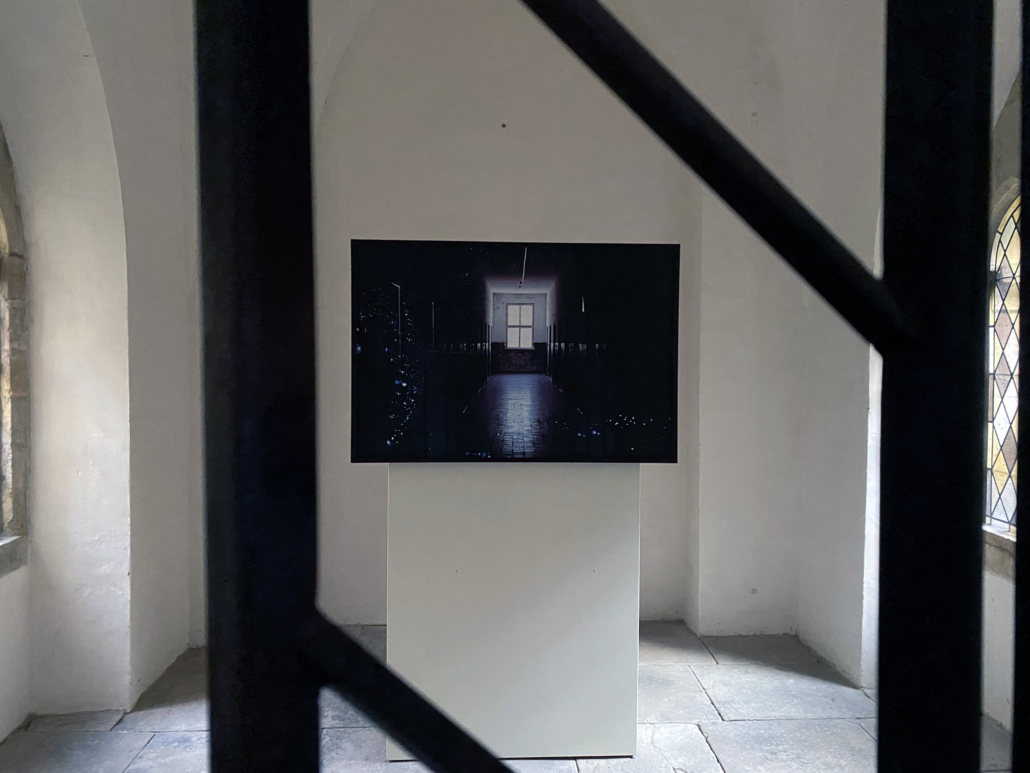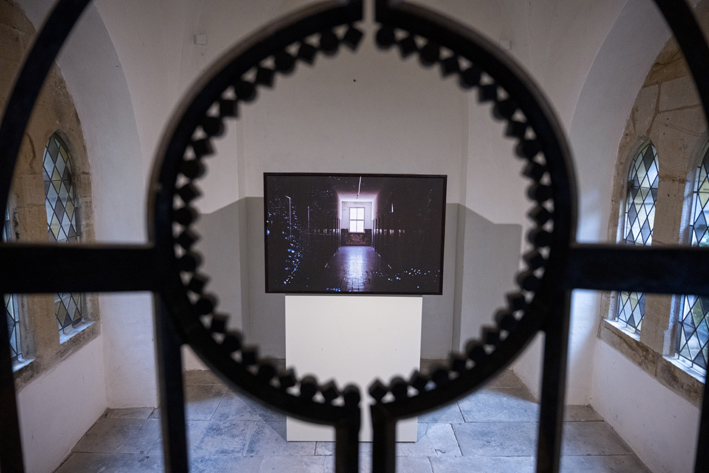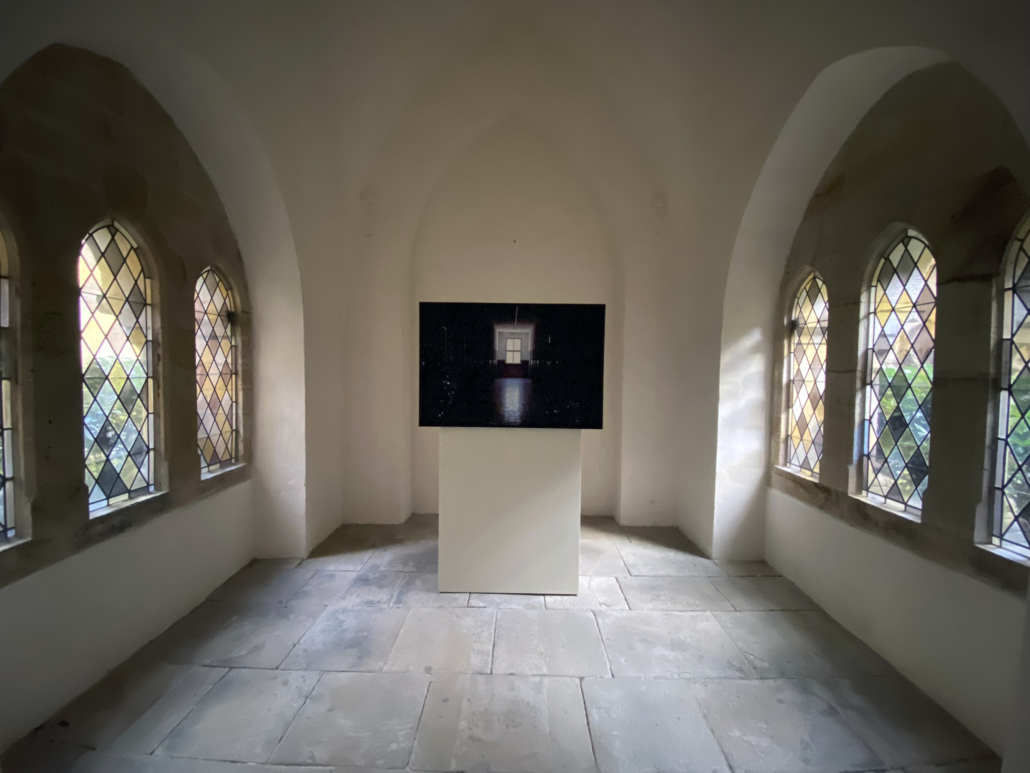WOLFGANG HUBER LANG | M 48° 15′ 24.13″ N, 14° 30′ 6.31″ E
The exhibition title could not be more objective: M 48° 15′ 24.13″ N, 14° 30′ 6.31″ E are the coordinates for Mauthausen. What interests Marko Zink is not documentation but irritation. He forces viewers to look carefully, opening up a multilayered debate. Using the medium of photography, he attempts to make a twofold disappearance visible: the extermination of people and the eradication of memory. It is an intensive engagement with a past that will not expire. The medium chosen by Marko Zink is analog photography. He manipulates the material before exposing it: He boils it or stamps it, treats it with chlorine or ink eraser. Using this delicate material, he photographs selected sites in and around the former concentration camp. Sometimes Zink’s works seem like found historical photos, taken quickly and in secret, bleached by the sun, half destroyed by the ravages of time. On a separate plane, the photos’ injuries seem to give an account of the atrocities that took place there less than eight decades ago. And sometimes they seem to make visible what seemingly cannot be seen anymore. With his work, however, Marko Zink reminds us that this is still possible: that which remembers the past, and that which warns against what is to come – we can see it all. If only we want to.
MARKO ZINK | M 48° 15′ 24.13″ N, 14° 30′ 6.31″ E
Mauthausen is synonymous with the Holocaust in Austria, stands for the most unspeakable, inhumane atrocities in the country’s history.
Mauthausen is an edifice, a memorial, a site, exposed on a hill, still hidden to the cursory glance, surrounded by fertile farmland and hunting stands.
Did you know that by now all the original shower heads of the former gas chamber are no longer there, that they have been secretly removed by visitors?
The Nazi regime swept away any democratic victory; nothing remained but hatred for people, for each individual that contradicted their racial ideology. Enemies were invented. The populace was manipulated and let itself be manipulated. The collective this created wiped out the self-determined individual. And this, in turn, relegated the ostensible “other” to an amorphous mass ready for extinction.
Did you know that each barracks (52 × 8 meters) “housed” an average of about 500 prisoners?
This system made us perpetrators. Both the (collective) attempt to explain—“we did not know”—and the claim that Austria itself was but a victim of Germany are still going strong today, but these reassuring stories do not actually provide reassurance as they have never been true.
Did you know that Mauthausen had a soccer field, located right next to the “quarantine camp,” and that not only SS officers but also nearby residents were invited to big soccer games while the concentration camp was in operation?
Did you know that shortly before the “liberation” thousands of dead bodies were interred on this soccer field as well as in the immediate surroundings at one of the area’s most prominent lookouts, the “Marbacher Linde,” without a single reference today to what happened there?
Did you know that these dead bodies were only exhumed as late as the 1960s and for years stored in coffins at a military base by the garage yard, directly in the former concentration camp, before the identified bodies could be flown to “their” country and interred there?
These questions lead to my multipart series of photographs. The works are complemented by titles that permit several approaches and perspectives: geodata, background information about the individual shots, titles borrowed from Theodor W. Adorno’s writings, and titles by Thomas Licek, the project director of the Month of Photography Vienna.
FELICITAS HEIMANN JELINEK | Through The Lens Of Marko Zink
The reality in Marko Zink’s photos is staged. It is the photographer’s reality—one into which he actively intervenes. As all the photos are analog, there is film stock. And the film stock was manipulated. Negatives were cooked, treated with acid or ink eraser, perforated, punched, glazed, or scratched. They were subsequently developed in various formats. The manipulated film stock led to manipulated photos. The photos show a reality that does not exist in this form. It is the work of the photographer.
The intentions behind this process are many: For one, the pictures suggest that they are historical photographs that are fading, in a state of disintegration as victims of time. They elicit a feeling of helplessness over the fact that the history of a concentration camp cannot even be grasped in its actual reality. They make painfully clear that the realities of life and suffering in Mauthausen become less and less traceable—also in light of the gradually diminishing number of firsthand witnesses—so that we cannot imagine being “exposed . . . to so much suffering,” as the former prisoner Pablo Escribano put it. Beyond the fear of losing the witnesses’ reality, the emotional impact emanating from the site of the Mauthausen concentration camp is heightened by the traces of chemical manipulation. This is possible in artistic photographs that deal with the subject of the Shoah. They may withdraw from discussions about the adequate examination of historical source materials as they transform their subject. Additionally, the photos challenge the viewers as they question their competence to see and interpret. When the viewers engage with the works, they are forced to deal with the place.
(…)
The approach of Marko Zink’s photos—and I deliberately do not call them a “photo series,” as they lack any serial character—is utterly novel. It is an approach that defies all ritualized forms of remembrance of the Nazi regime and the Shoah. The more ritualized the commemoration—be it in educational mass events or during politically decreed festivities—the more questionable the gain. Official commemoration rituals are formulaic and lifeless realities that Marko Zink challenges with his reality.
LEILA TOPIC | Text to the presentation of the series M 48° 15′ 24.13″ N, 14° 30′ 6.31″ E in MSU in Zagreb
The aporia of concentration camps is ultimately the aporia of historical cognition: the mismatch between facts and truth, the gap between establishing truth and understanding it. Zink takes advantage of this gap: Unprepared viewers will be amazed by the aesthetic appeal of some of the photographs. When they get closer, they will be shocked to learn, thanks to Zink’s written explanations, about what they are observing. An artist can represent a scene. What’s difficult, perhaps impossible, to show is the experience of what passes beyond all comprehension, both then and now. However, Zink, precisely because of the aggressive techniques with which he treats the film, manages to bring closer the experiences of unremembered destinies. He reinscribes the human body in the scenes, bringing us closer to the sense of meaningless disappearance.
GENEROUSLY SUPPORTED BY
Future Fond Of The Republic Of Austria | Cultural Departement Of Vorarlberg, Austria | Cultural Departement Of Vienna, Austria | Cultural Departement Of Upper Austria | Federal Chancellery Of Austria | Otto Mauer Funds, Austria | National Fund, Austria | Bildrecht, Austria | Mauthausen Memorial, Austria | Michaela Stock Gallery, Austria | Society for Christian Jewish Cooperation Osnabrück, Germany | Federal Ministry for Republic Austria European and international Affairs, Austria | St. Katharinen, Germany | Evangelisch-Lutherische Landeskirche Hannover, Germany | Bistum Osnabrück, Germany | Museumsquartier Osnabrück, Germany | Evangelische Stiftungen Osnabrück, Germany| Hans-Lilje-Stiftung, Germany | ZEIT-Stiftung Ebelin und Gerd Bucerius, Germany | Austrian Cultural Forum Berlin, Austria | Austrian Cultural Forum Zagreb, Croatia | MSU – museum of contemporary art, Croatia
EXHIBITION | Vorarlberg Museum | 2022 – 2023
EXHIBITION PHOTOGRAPHY | Miro Kuzmanovic
EXHIBITION | Vertikales Museum | Felix Nussbaum Haus im Museumsquartier, Germany | 2022
EXHIBITION PHOTOS | Hermann Petermann | Marko Zink
EXHIBITION | MSU – Museum of contemporay art, Croatia | 2021
EXHIBITION PHOTOS | Marko Zink
EXHIBITION | St. Katharinen, Germany | 2022
EXHIBITION PHOTOS | Marko Zink
EXHIBITION | Dom St. Petrus, Germany | St. Nikolaus Kapelle, Germany | 2022
EXHIBITION PHOTOS | Hermann Petermann | Marko Zink | Michaela Stock
EXHIBITION | Mauthausen Memorial, Austria | 2019 – 2020
EXHIBITION VIDEO | Mauthausen Memorial

